What's your problem?
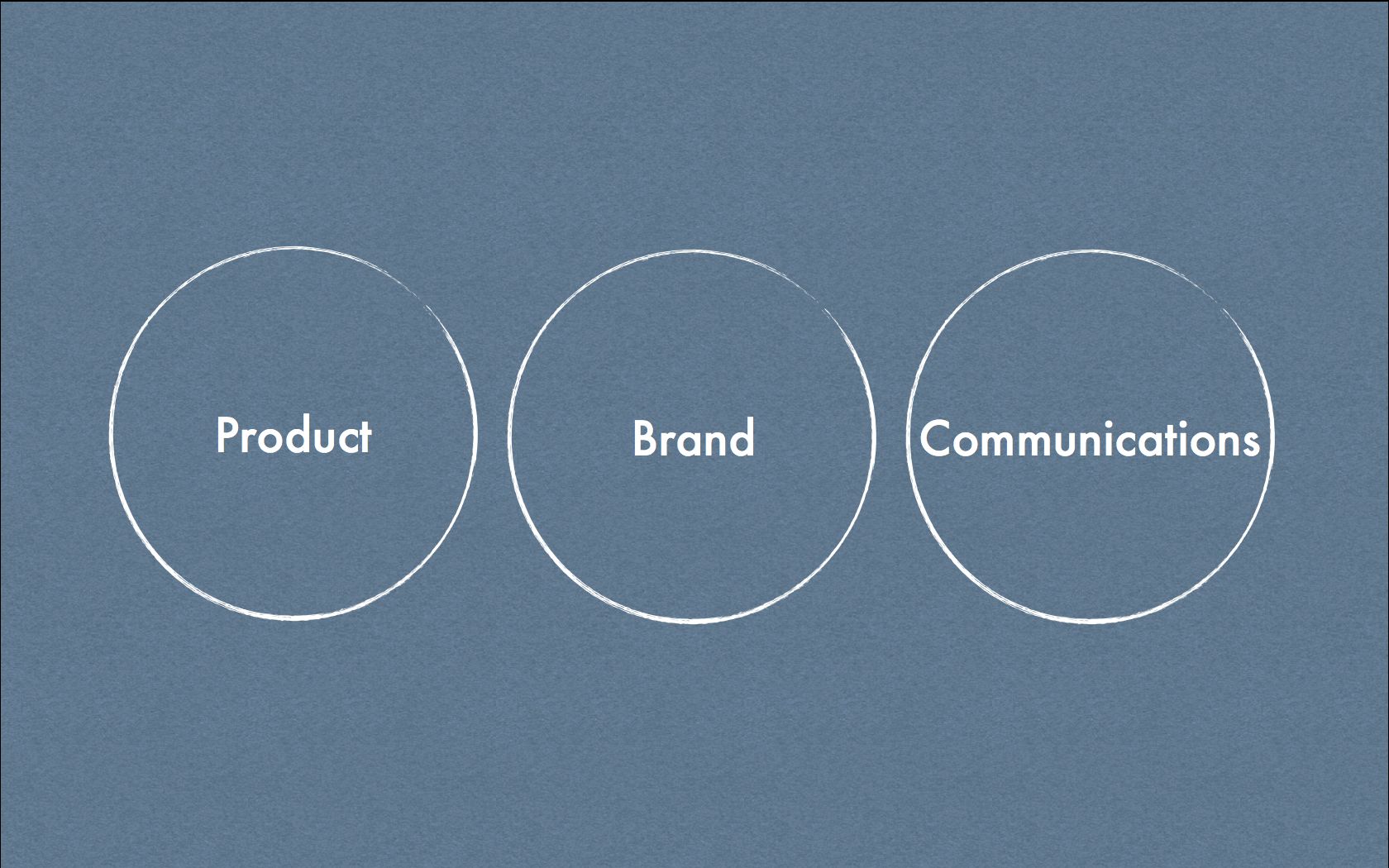
All great marketing solutions start with a well and accurately defined problem and a correct diagnosis of the course of action that needs to be followed. So I thought I’d talk a little about this to kick the new year off in a back to basics style.
There is a very basic diagnostic tool I want to share with you that works a treat at the very start of a project and ensures that you are directing your efforts in the right and most profitable direction.
It involves asking whether you think the real problem that needs to be solved, the blockage that needs to be opened up, is a product, brand or communications problem.
And the starting point is to scrutinise the product, service or occasionally business - to ask whether the problem lies at the product level.
A problem with the product is pretty fundamental. This indicates that in some way what the consumer is being presented doesn’t work for them - whether because of performance, pricing, distribution/accessibility. It may well be that you can’t do much about this - certainly in the short term but it is nonetheless valuable to know as you try to put your plans in place that they will always be compromised because you are not bringing the right product to the consumer. I worked on Pot Noodle for a while in the early part of the last decade. While magnificent work has been done at both brand and communications levels to help Pot Noodle the fundamental problem is at a product level. It’s not that some people don’t love Pot Noodle - they do - but the market for dehydrated soya protein snacks is literally drying up. The product needs re-formulating if it’s not to die out altogether.
If there appears to be no fundamental product issue it is time to move on to the brand. Is there something about the brand and specifically people’s relationship with or beliefs about that brand that are holding sales back. Many perfectly good products are compromised by unhelpful brand associations that ensure their popularity is not far greater with predictable effects on sales. One of the classic examples of this in the automotive category was, of course, Skoda. Under new ownership product quality had been transformed, however perceptions of the brand dated back to the cold war era. Or to be specific brand associations amongst Skoda buyers had been improved through experience but the jokes about the brand persisted in the wider group of influencers and this was having a detrimental effect on sales. Skoda had to deal with the brand problem first and foremost.
And finally if it’s not a product or brand problem it’s probably a communications problem - that the communications for the brand are not telling the right story, working in the right way or targeting the right people. In a sense this is to be welcomed as it’s a damn site easier to sort out a brand’s comms than the brand itself the product or business at it’s core. In the first half of the last decade Cadbury weren’t doing particularly well. This had nothing to do with the product (people adored the taste of Cadbury’s Dairy Milk) though that didn’t stop them spending time, energy and valuable distribution on NPD. And quite obviously there wasn’t really a brand problem either - Cadbury’s place in the affections of the nation was secure and the nature of its brand associations rich and robust. Its problem was with its communications - they were simply failing to inspire people and successfully communication the joy at the heart of the brand. That all changed in August 2007 thanks to that drumming Gorilla. Of course the communications solution required may not be about or only about the content you create. It could well be the audience you are targeting, the channels that you are using or the brief at the root of your campaigns - the selling idea that you are employing. If the requirement is to create behaviour change finding the trigger for change is often at the heart of the matter - I’m still a big fan of the Metropolitan Police campaign that set out to recruit high calibre candidates by communicating that 999 out of 1000 people could never be police officers.
Now, you might find all this simplistic, old hat or old fashioned. But it doesn’t half help me right up front to understand and show where the problem lies. I used it at the beginning of our journey on WeightWatchers to show that there was no fundamental product problem at hand and that while its communications could be better they were quite successful for what they were. What was holding WeightWatchers back as a business were perceptions of the brand among people that had never tried the programme, and that is what they needed to sort out.
‘Tis the season to obsess about trends.

Image courtesy of SonOfJordan.
For those of you frustrated by the lack of sense my trends presentation makes when you only have the charts, here is the story. I wrote it as a column for Brand Republic so its not identical but covers much the same ground.
On the cusp of a new year and in a climate of abject fear about the future, the marketing world is naturally falling over itself to procure the views and services of the trend-spotting world. If only we can make sense of the madness or at the very least look like we know what is going on, perhaps the world will be a better place, or at least seem a little less complicated.
And when they are not being pressed into service to reassure us that everything is going to be fine, trends also offer us all a little light relief, because lets face it the average trends presentation is down right hilarious. This is, after all the natural habitat of the portmanteau, that linguistic flourish invented by Lewis Caroll in ‘Alice through the looking glass’ but so beloved by the trend watching world. Whenever life gets a little hairy you can always chortle to yourself over gems like tribefacturing, engageonomics, materialism and other such abominations so ludicrous that they send your spell checker into spasms as you type them.
So given their pretence to predict, their power to reassure and their ability to entertain it’s no wonder that marketers love a good trend. However, call me old fashioned but I can’t help feeling that while trends are trendy, it is insights that really get stuff done. And it is insights rather than trends that we should all be reaching for as times get tough. Insights like the one that underpinned the AA’s legendary 4th Emergency Service positioning and so profoundly built the business in the mid ‘90s.
Of course as we all secretly know, the problem with really great insights is that, like the White Rhino, they are almost completely extinct in the wild. The sad truth is that for all the research departments that have been rebranded ‘consumer insight’; all the boxes marked ‘insight’ on client brand diagrams; and all the words on agency creative briefs about ‘insight’, real insight is very, very rare. Just because you call it an insight doesn’t make it one.
I can ‘t help feeling that this is a problem of definition. Not the lack of definitions for insight but the fact that there are far too many, most of which wallow around in the nebulous and uninspiring world of consumer or brand truths. What we are in desperate need of is a new action standard for insight. Much like the universities demanded A stared A level grades so they could tell who the really clever kids were, we need a new way to determine whether what we have in our hands is gold dust or guano.
That’s why at Saatchi & Saatchi we use the word revelation in place of insight. This isn’t yet another definition it’s an action standard that demands people raise their game and their expectations when it comes to finding and delivering insight. A revelation does exactly what it says on the tin, it insists that what follows is in some way an astonishing disclosure about people, the brands they engage with or the wider world. No revelation, no insight, it’s as simple as that.
And how to you find revelations? Well I have a few handy tips to help you on your way.
Firstly and simplest of all, ask yourself does it sound and feel like a revelation to you? Is what you have found, been told about or read truly an astonishing disclosure or is it a statement of the bleeding obvious ?
Secondly, real revelations live in the real world not in viewing facilities or behind one-way glass. They show themselves in the day-to-day lives of your customers as much to be observed as reported on. Get out and understand what your customers really care about and what is actually going on in their lives.
Thirdly, in the words of that great marketing commentator, Donald Rumsfeld, look for the unknown unknowns. Revelations will come from the least expected places not simply from finding the answers to questions that you already have – look for the things that you didn’t know, you didn’t know.
And finally the truth is that much that claims to be insight in the world of marketing is actually corporate wishful thinking that over estimates the importance of a brand or product in people’s lives. The route to revelation is through banishing vanity and accepting the honesty and rawness of genuine insight.
Enjoy the conferences, articles and presentations about the killer trends for 2012, but remember two things. Try as I might can’t find a single presentation on trend predictions for 2008 that contained the phrase ‘global economic cataclysm’. And remember that it’s genuine and behaviour changing insights – revelations even – that offer the best protection and opportunity for our brands in the coming year.
Trends are trendy, insights get shit done
My new rubber stamp. If there is enough interest I might get some more made.
I gave a talk at Haymarket's Trends Plus conference this week. I'm sure it was a wonderful shindig - the speakers I saw were excellent - but I couldn't help feeling a bit contrary about a conference on trends. I've never had much truck with the 'cool hunting' fraternity, about predicting the future and about making money out of stating the bleeding obvious. Or for that matter from Portmanteaus - the ghastly habit of sticking two perfectly good english words together to make a new word that is both ridiculous and unnecessary. You know the sort of thing maturialism, tribefacturing, the statusphere, or engageonomics. Anyway here is the presentation. As usual it makes very little sense without the talk that goes with it, but you might get something out of it. Slideshare have been kind enough to feature it on their home page today.
How to run an agency

Tango, undoubtedly Jon Leach's most famous planning hit, or was that the 4th Emergency service?
I don't often get to APG talks, to my eternal shame. However, yesterday I made a point of trucking up to the eternal ghastlyness of the Bloomsbury Holiday Inn for Jon Leach's talk on the mathematics of creativity.
Jon has been working on this idea for a while now, whether you can explain any of the things that we intuitively believe to be true about our business using mathematics. The belief being that this would allow us to communicate the method in our seeming madness to our left brained colleagues - namely CFOs and Management Consultants.
Of course I love the substantiation that brainstorms are pointless because the social cost of interacting with so many people defeats the marginal increases in creativity that greater numbers bring. The ideal number of creative thinkers in a room being four.
And he talks about the need to find one in a thousand ideas because only the one in a thousand ideas have the power to stay in the mind and act on people for months into the future before decaying. Which is nice because it kinda justifies why we need time to think and create in agencies which often frustrates clients - because we are having to come up with hundreds and hundreds of ideas in order to find the one that is extraordinary.
Anyway he talked about an formula for running a successful creative business which I also really liked.
1) Create a preponderance of ideas in the risky (or chaotic) zone
2) Spot the gems and develop them just enough to knock off the rough edges
3) Stop before you grind them to dust
While this seems easy peasy, at every stage you need enormous amounts of experience and judgment to make the approach work. The sheer quantity of work out there that has never visited the chaotic zone of creativity and if it has, has been so sanitised by second guessing and testing is ample proof that these are rare qualities indeed.
So thank you Jon. Your talk was kind of geeky, but then us planners are the geeks of the ad business.
Welcome to the age of micro-planning

Downstream - where planning is heading. Image courtesy of SunnyUK
I had the absolute privilege of judging the Account Planning Group Creative Strategy awards recently. I love the APG Awards, they showcase real planning and great planners in a way that the other so called planning awards do not. And for me this year saw a return to form for the awards. In all there were 26 presentations from some of the best in the business, delivered in person, which is one of the reasons the awards are so special – for planners and judges alike.
This year’s shortlist has been public for a while. And there is everything in it from extremely famous campaigns like Cravendale’s Thumb Cats, the Yeo Valley rappers and The Stella ‘She’s a thing of beauty’ campaign to an internal project at Weiden’s to reduce energy consumption, a Japanese bottled water that cornered the market with a new collapsible bottle and a campaign to help demobilisation of FARC Guerillas in Columbia. Clearly I can’t let on what has won yet but every one of them is worth a read when the papers are published shortly.
That said I think there was a clear difference in this year's papers and presentations. A lot less brand planning (though there are some splendid examples) and a lot more micro-planning. I have no problem with the downstream approach to planning, it has always represented proof that the planner is more than a brief writing machine and is capable of and welcome to bring their skills to bare on the more executional facets of a campaign. This is particularly the case when real time planning is required as a campaign unfolds and evolves.
That said it seems a shame to me if planners are walking away from, or unable to deliver, ‘upstream’ brand planning. Planning that either repositions a brand in the marketplace (such as Matt Boffey’s Lurpak work or Craig Mawdsley’s Sainsbury’s thinking which both won in 2007) or shapes a communications campaign with a clever reframing of the problem or sharp proposition (think Richard Storey’s Met Police campaign or Stuart Smith’s Positive Hate thinking for Honda).
So why are we seeing a lot less brand planning and a lot more micro planning? Indeed this year’s particular theme was the selection and prioritisation of celebrities according to their social media reach. Worthwhile but not really award winning. Personally I don’t think it’s the quality of our planners, I rather suspect it is the quality or nature of the briefs that we receive and in particular the pitch briefs that we get.
Once upon a time in a land far, far away clients would issue pitch briefs with the commercial problem they were seeking to solve and ask a selection of agencies at the top of their game to answer that problem by any means they felt necessary to meet the objective. That was a brilliant time for planners because our role was to work out how to use brand and communications and their meaning and content to change people’s behaviour and thus solve the problem. That’s why Craig Mawdsley’s Sainsbury’s paper is so good and won a Grand Prix, it starts with a commercial problem and shows why asking people to try something new today would and did deliver incremental sales to Sainsbury’s.
However, this kind of pitch has become rarer and rarer. For one thing the this shoddy Government has turned its back on communications led behaviour change after decades of success in doing this – there were a lot fewer UK Government papers this year (though notably the Governments of Iceland and Columbia both retain a faith in what we do). But more importantly Clients are arriving at our doors having done the planning bit – whether this is good, bad or indifferent. Often this has been with some kind of branding agency or research company and it’s rarely that edifying. Clearly every client has the right to do this but it means that Agencies are given briefs to execute work to a brand idea not to solve a commercial or social problem. In one pitch this year the planning had been done entirely at the previous incumbent and then the creative brief shipped out to a selection or new agencies – which must still stick in that planners throat, especially as the thinking was award worthy but severed from the creative work by the review.
Micro-planning, downstream and real time planning have all been a welcome addition to the capabilities and remit of the strategist. However, these approaches should have been in addition to our role in providing the first moment of transformation in a brand’s future or in the success of its communications rather in replacement of it. Call me old fashioned but I’d still prefer to be delivering exciting new futures for brands not just fiddling with the execution of the creative work.
The APG Awards are announced on Thursday 6th October.
Leadership 101
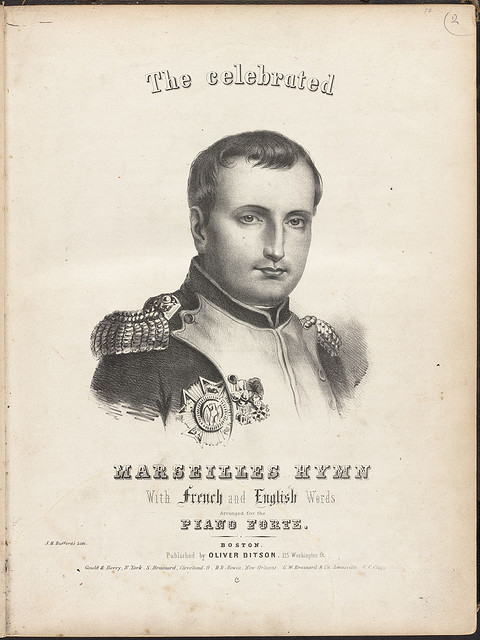
Napoleon, the source of the first leadership lesson. Image courtesy of Boston Public Library.
I was recently asked to talk about leadership. Now, those that know me might think this is a faintly ridiculous idea but there are a few tips on leadership that I have picked up along the way, that I use all the time in leading planning departments and agencies. So I thought I’d share these with you whether you are a leader or aspire to be and whether you work in planning, advertising of any other field.
When it comes to effective leadership I have eight rules or principles that I try to live and work by. Each I have learned from someone or from a particular experience, good or bad. So in each case you are going to get the principle and the person or circumstance I learned it from.
Here are the slides I use.
1. Leaders are dealers in hope
This little quote is from Napoleon but I found it rather bizarrely via the actress Sue Johnson, or rather her character Grace Foley in the BBC crime drama Waking the Dead. There, now we know what I do on a Sunday night.
I love this quote. While on face value it might be read as leaders are dealers in bullshit, its actually about our role in giving people hope and a sense that it is all worth while. When Churchill said to the people of Britain on November 10th 1942 “Now this is not the end. It is not even the beginning of the end. But it is, perhaps, the end of the beginning” he was doing precisely that – dealing in hope. Hope steeped in realism but hope nonetheless.
For god sake be transparent, for god sake never bullshit your people but remember you are a dealer in hope and a sense that whatever you require of them, that effort is worthwhile and with purpose.
2. Leaders should only do what only leaders can do
I learned this from a Guy called Kevin Duncan. Kevin is an ex adman and now prolific author on the subject of productivity. He taught me this in a talk about his book, Tick Achieve. I lapped up Tick Achieve because I am absolutely useless at getting things done and so this Janet and John guide to doing just that worked a treat.
The idea that leaders should only do what only leaders can do is a bit trite but boy is it useful. Whenever you are faced with the need to prioritise your workload or simply to slim it down recite this mantra to yourself and ensure that the tasks that are occupying your time are those that no one else in the organisation can deliver. If they are then ask yourself whether you wouldn’t be better picking up the phone and asking someone else to take on that challenge.
While this works well as a rule of thumb for delegation it also disciplines you against spending your time doing the things that you feel comfortable doing and hiding form the real challenges you must address. So go ahead and do what only you can do.
3. Be a master practitioner
I love Gordon Ramsey for all his manifest faults, abject arrogance and messed up businesses. And in particular I have always loved Gordon’s Kitchen Nightmares in which he marches into some hapless restaurant that is down on its luck and sorts the place out. He is naturally extremely confrontational in this process, much to the annoyance and discomfort of the owners. However, in most cases he does manage to win the restauranteur over to his approach and for one simple reason, he can cook. What I mean is that in the final instance any restaurant owner has to respect Gordon because no matter how arsy he is being he has a constellation of Michelin stars under his belt. Gordon’s prowess in the kitchen is and will always be his source of authenticity and authority.
So when it comes to leadership I strongly advocate that you keep your hand in at your craft skill and more than that you use any opportunity to show the people you lead that you got to where you are because you are bloody good at what you do. In other words you are a master practitioner at your trade and not some numpty that has got to the top without any discernable talent but simply a knack with corporate politics and climbing greasy poles.
4. Create respect, give love
I learned this the hard way from an episode in which I witnessed the leadership of someone under my care crash and burn and had to both figure it out and sort it out.
In an ideal world you would love and respect your people and your people would love and respect you. However, this is not necessary for effective leadership, its nice but not necessary. What is necessary is that your people respect you, in other words they believe that you hold the position you do because you are good at what you do. They do not need to love you, simply respect you. You need to take steps to ensure that people do respect you and by this I do not mean pulling rank or shouting at them, neither have the effect of building respect. By the same token the primary emotion you should feel for your people is not actually respect but love. You have to find a way to love all of the people you are responsible for leading no matter how tough this feels sometimes. Yes even the ones that are a pain in the arse or who want your job.
If they don’t respect you and you don’t love them, I’m afraid your leadership is history. Many an Arab Dictator might be well to remember this.
5. Energy and commitment trump ability anyday
I leaned this in the first year of taking up the position if Director of Strategy at Saatchi & Saatchi. We were put in as a new management team to turn the agency’s fortunes around and restore its creative birthright.
As a planner from a maverick tradition and having spent a decade at HHCL, I was convinced that my contribution to my new home would be intellectual. I would descend and bestow my contrarian strategic approach on the planning culture and the agency at large. Planners would become more edgy and intellectually dangerous by taking my lead.
The truth was this was not the greatest contribution I made to the agency. Or even one of my main contributions. My contribution had a lot more to do with shoe leather, lots of espresso and a shed full of expletives.
Walk the floor every opportunity you get in the day. Exude energy and enthusiasm, flirt, take the piss out of yourself, swear, a lot, dance, pick up people’s concerns, ask them how they are and what they are wresting with, get reminded about the stuff you promised to do for them but have forgotten about. You know that kind of thing.
When it comes to leadership I believe that your energy and enthusiasm is often a more important contribution than the contents of your brain.
6. Remember the workers plea
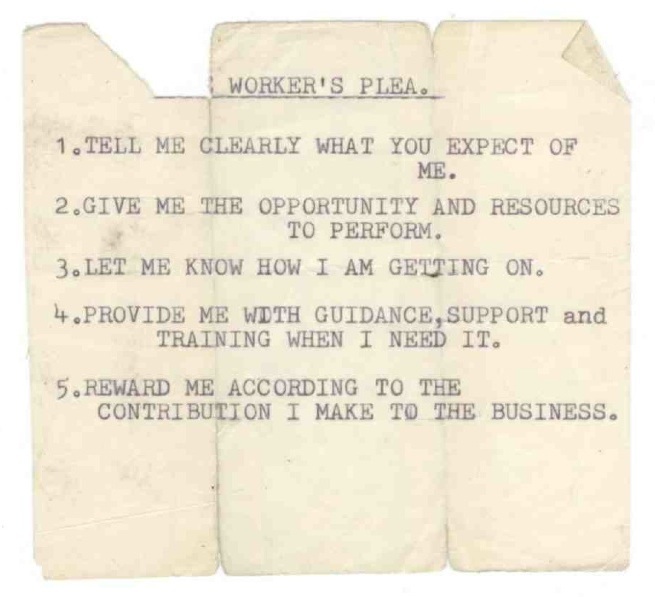
Avid readers of adliterate will remember the workers plea, the piece of paper my father carried around in his wallet for thirty years.
I’m not too sure where he got hold of it but it articulates five basic requests from employees of their bosses. In truth this might be better in a post on management rather than leadership but its clear that people are far more willing to be led if they feel that they are being looked after and looked out for. And that’s what the worker’s plea is all about – being clear what it is you want from and giving them the opportunities and resources to deliver this.
At the time I got alot of comments (ah those were the days) from people in the US accusing me of spreading communist propaganda. You don’t often get that if you work in advertising.
7. Titles don’t mean shit
I worked for Steve Henry for a very long time. One of the greatest British copywriters of all time and thoroughly nice bloke, Steve was the co-founder of HHCL, my cultural home for a decade. One of the things that marked HHCL apart from other agencies then and now was the absolute loathing of hierarchy that was baked into the walls at the place. Anyone seeking status symbols to mark their career progress was well advised to give HHCL a wide birth as there were quite literally no perks to that job but for creating some of the most notable and important advertising on the late 20 Century. There were virtually no titles and no ladder to climb so that the only way that you got ahead was to consistently produce the work that the agency loved. In other words you were known for your work and not your title.
Unfortunately in most agencies and organisations in general the pursuit of status is almost toxic. It’s toxic for the people that have to endure status seekers and actually quite toxic for those individuals that pursue it. Status puts distance between people and intimidates those who you really need to be bounding up to you on a regular basis, feeding you with ideas and letting you know what is going on.
I’m not saying you should tear up your business card, titles can be important for you, your people and the outsiders that you meet. But for fuck sake don’t let it go to your head. Insist you are respected for your work and not your position and find ways to sacrifice some of the trappings of your position.
8. Don’t just enjoy your work, enjoy their work
Finally my absolute favourite thought and practice. I learned this from the conductor Itay Talgem in his TED talk in 2009. His view is that the best conductors are co-creating the performance with the orchestra, neither dominating them nor absenting themselves from the occasion with a few perfunctory waves of the baton. What this means in the moment of the performance is that that orchestra is not necessarily being led (much of that work having been done in rehearsals) but being encouraged.
For me this boils down to showing people that you enjoy the work that they are doing and producing. In our world this is more common for creative teams who enjoy a more direct response to their work. But it should apply equally to the other people in an organisation. Next time someone finishes presenting try telling them that you really enjoyed their presentation rather than simply that you thought it was good. Same for a good brief or a great contribution in a meeting.
That’s eight top tips and that’s your lot. Do I practice what I preach? Well I try.
Crisis, what crisis?
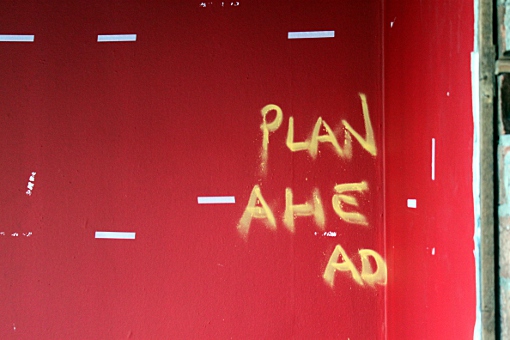
What's the plan for planning? Image courtesy of see_another_side.
A few years ago in an orgy of self-congratulation and a pithy monographs invoking the spirit of King and Pollitt, planning turned forty. The second great advertising innovation of the twentieth century alongside Bernbach’s pairing of creative teams seemed confident and cocksure with a rosy future ahead of it both within the advertising development process and beyond it.
However, far from being in the rudest of health I wonder whether planning is actually in crisis, the result of a combination of external and internal factors that are putting it under considerable practical pressure. For the first time in my career, I’m not sure we can take the future of the discipline for granted and certainly not in its current form.
No one doubts that clients want greater help navigating the minds and actions of consumers or that they have an insatiable demand for insight but has anyone bothered to let their procurement departments know? The fee negotiations that all of us have been subjected to over the past couple of years were characterised by unparalleled brutality. And its often planning that gets compromised first in the desire to descope the agency offering to match the figure procurement has plucked out of the air.
Of course, its not all about penny pinching, in part we are under pressure precisely because of planning’s success as an idea and as an offering. Few clients outside the media industry believe that there is much value in taking creativity in-house, recognising that their cultures and opportunities do not attract the best creative practitioners. But that’s not been the case with planning. Clients are increasingly keen to absorb more of the planning function into their own head count and marketing departments. And with those skills on board they feel less inclined to out-source them to their agencies. Witness the number of pitches in which clients come not only with a problem but also half a solution and it’s the planning half of the solution they have under their arms.
Simultaneously we are all trying to understand and enagage with our audiences at a time of unparalleled cultural and technological change. And specifically how to construct a planning offering that is capable of meeting this need while also offering more traditional brand advice and strategic counsel to our clients. Not in blogging lah-lah land but at the agency coalface where planning heads are trying to balance real revenue with much needed investment. As the skills of the strategist fragment we have to find a way to afford a core offering of generalists as well as a stable of strategic specialists. And we have to figure out which specialist skills we need in house, which will be offered by partner agencies and which will continue to be sourced on the open market.
It feels to me like a perfect storm of declining revenue to pay for our people and expanding skills that are required of them, that’s the crisis that planning is facing.
Now, for the more myopic of you this may be a cause for celebration, planning has often been seen as a source of frustration for both account handlers and creatives, in part because of the way it has de-skilled both of them. With an entire group of people focused on communications effectiveness, account handlers have lost their strategic instincts and with creative departments offered much of the solution in the brief they have lost the salesmanship so beloved of Ogilvy and Abbott.
But before you crack open the Krug pause for a moment to think what this says about the direction of travel for our business. Let planning follow the media boys and girls out of the door and we recognise that advertising agencies are no more that outsourced creative departments, there to do little more than the colouring-in for clients that already have the solution to their business problem and just need a selection of creative ideas to they can choose from.
Agencies need planning because though it’s true that great and effective advertising can be created without us, planning makes sure both these outcomes happen more often. But that need has to be based on real value to client and agencies alike not bodies that can be charged onto the client to bump up the fees on the account – those days are over. And for that reason I think we may need to look at the way we organise planning.
Since the birth of the planning we have modeled our departments on that of account handling. Planners have always been allocated to specific accounts like their account handling partners working hand in glove with them on a daily basis. This approach has clearly been effective but it’s also been rather cosy creating an environment where the mediocre can hide, the brilliant get lost, and we have by necessity to create one-size-fits-all planners because every one in the department is doing broadly the same job.
This isn’t the case with our creative colleagues. Teams are rarely allocated to clients but instead a pool of increasingly diverse creative talent solves the creative problems the agency is faced with. One team can be allocated to a project or many and they can either work competitively or collaboratively to find and execute the best solution. Some teams may be more familiar with a client than others, however real institutional knowledge is held by the Creative Directors or ECD who match the best talent to the task.
Perhaps it’s time to operate our planning departments more like our creative departments. And to do so because it might offer a better way to add value to our client’s, to our agencies and frankly a more rewarding way for our best talent to work. With a pool of diverse planning skills, including deep specialists and anchored by a core of generalists, Planning Directors can match the needs of the task with the right talents and in collaborative teams working collectively and quickly to solve problems. Institutional knowledge and continuity of care for the brand would be retained by Planning Directors rather than at every level of the department. And without the need staff the department with one-size-fits-all planners allocated to accounts budget is freed up to invest in strategic specialists.
Of course, in doing this we would fundamentally disrupt the model of planning that has worked so successfully for 40 years. We will upset those clients that want dedicated planners throughout their business. And we will un-pick the rewarding and powerful relationships between suit and planner that we have always enjoyed.
However, we would also escape from a system that has made planning cosy and lazy and called into question our value. A system in which planning has been taken for granted by clients and agencies, offered and bought as part of a package without real scrutiny of the value being added to either party. Value we have to deliver more consistently and with greater speed in order to defend our revenue and value that we can only truly offer now by freeing some of that revenue to be spent on the specialisms we need to make sense of the world and deliver more effective solutions.
This post was first published as an article in Campaign Magazine
Developing your own planning style remix
Here are the useful bits from the presentation I did last week to IPA 4. Thanks to Mr Tom Morton for pulling the whole show together and to all the planning heads that helped me by illustrating their distinctive planning style.
The problem with participation
 Now that's a swisssh. Image courtesy of ..Emma..
Now that's a swisssh. Image courtesy of ..Emma..
The participation band wagon rolls on in adland with agencies and clients seeming content to sacrifice effective communications for a couple of the clinically insane and the entire staff of the PR agency uploading some old tat to a website in the name of ‘doing something on facebook’.
We are all aware of the howlers like the much ridiculed Kingsmill Confessions and my personal favourite, Pantene’s upload your swish. Despite Cat Deeley reassuring us that everyone is doing it (that’s uploading their swisssh) I can find proof that only 1,925 women have actually bothered. And when they can drum up a following, how many participatory campaigns are actually working as pieces of effective communication? Its true that McCain have managed to bribe 11,000 people to like their ‘guilty secret’ facebook page (good knows why but lets assume it’s the freebie trip to New York that is the primary motivator) however research by Wavemetrix suggests that few people are getting the basic idea that McCain rustic oven chips are a healthier option, which surely is the reason the Client is paying good money for this activity.
So how do you get it right? Well there have been some excellent posts on planning for participation recently with few more helpful than this from the excellent Patricia MacDonald at Planning in high heels. She identifies the need to understand who you really want to participate and to what degree and critically what their motivation fpr doing this will be. Not to mention the need to understand the trade off between effort and reward which clearly seems to escape anyone using the word ‘upload’ in their current campaign. And of course there is the great Clay Shirkey matra about people needing the means, motive and opportunity to take part which works for me.
However, while all of this is helpful I think there are two issues that continue to dog participatory campaigns. The after thought issue and the performing monkey issue.
The after thought issue is based on my personal view that if you leave participation to the end of the planning and creative development process you are doomed, you have to plan for participation right from the start. But this isn’t about re-engineering the agency process, inter-discipline collaboration, briefing the creative technologist at the same time as the teams, putting communications planning (or whatever we are calling it this week) at the start of the journey or any of that noble stuff that seems to get people excited. Planning for participation is about building brands and communications that invite and inspire participation from the outset.
You cannot hope to involve people in a campaign unless the brand is up to something interesting. And you cannot hope to involve people in the life of a brand unless the brand seems to care about something or things that real human beings care about, rather than endlessly repeating the brand’s obsessions to them. And that’s about as complex as it gets, they are if you like three sequential steps to participation heaven.
1. Start by making sure your brand cares about something that people care about, that it has a point of view on or a contribution to make to the lives that they lead. I’d call out Good Food Deserves Lurpak as a damn good example of a brand that’s aligned itself with the values of food lovers across Britain. For my money this is the planner’s responsibility.
2. Then do something interesting with this. I know this sounds incredibly obvious but I’m going to bang on about brands being interesting and doing interesting until more of them do (like any of them are listening). Being interesting is the social currency of our age and the only currency we have to work with as the value of paid for conversations declines. The success of the T-Mobile campaign has had a lot to do with giving it a brand purpose in Life’s for Sharing but it’s the way that the brand has done interesting stuff with that idea that has driven extremely high levels of participation with the brand.
3. Then and only then do you deserve to ask the question. How are we going to enable people to join in and play? If anyone is playing with Old Spice and they do appear to be don’t they, then its not just because of the genius of Ian Tait, manifest though it is, it’s because the brand strategy is inspiring and the ads are fucking brilliant.
And as for the performing monkey issue? Well that’s for the next post ladies and gentlemen.
How unspecial are you?
 Image courtesy of Lufitoom
Image courtesy of Lufitoom
I was taking afternoon tea with the man-legend Russell Davies this week and amongst many random things we chatted about was the idea of Unspecial. I suppose at its heart Unspecial is about how similar we all are. While we all have our idiosyncrasies, we aren’t that special or unique as human beings, we like being part of the herd. Segment away you direct marketers but the truth is that more unites us than divides us. That’s why we have been able to take the Food Lover strategy authored in the UK for Lurpak and take it right round the globe – it turns out that while the food people love is culturally distinct a love of good food is not. People are Unspecial and so are you.
And I want to try and apply this idea to planning – perhaps we might call it Unspecial Planning.
I am a fan of real insight, the revelations derived from real I life not research. And the truth is that the very best place to start in deriving real insight is yourself – so called planning from within. Your forensic understanding of your own behaviour and attitudes is your best first step in understanding how to change that behaviour and those attitudes.
This technique involves starting every project not with a vast data trawl or a few groups but with a degree of self-examination. Its one of the reasons that I have long held that anxiety maketh the planner. It takes a dose of anxiety and introspection in order to really unpick why you do the things you do. By way of example I used this technique on Visa where the aim is to replace cash for small and medium value payments across Europe. I simply worried out why I paid for stuff by card rather than cash and how I feel when paying by card is not accepted or unacceptable. Forget convenience, speed or any of that rational stuff, the reason I use my card is to save my cash. And it turns out that I’m not so special.
Unspecial planning therefore is an approach about looking within yourself to find real behavioural or attitudinal insight and then figuring out exactly how Unspecial you are. That's when research is brilliant, to check out your level of specialness. If you turn out to be rather special it probably best to dump that sparkling new strategy you are about to unleash on a waiting world. However, if you happen to be a deeply unspecial human being then you may just have hit pay dirt
For what its worth
The post on Client briefs and briefings seems to have got a bit of interest so I thought I'd make available a rudimetary briefing format for Clients to agencies.
I'm sure that it's not perfect but it may help, especially if your clients or you as a client don't have an approach to briefing that is set in concrete.
What is the business objective?
This is the business outcome required from the activity. It roots everything we do in a clear business context and ensures the agency understands the bigger picture.
How are we going to achieve this?
This is the way that we believe that communications can have an impact on those objectives. This makes sure that the task for communications is credible.
Who will we need to convince in order for this to happen?
The target audience for the activity. Not the creative target but the clear volume opportunity. What do we know about them that is absolutely relevant to achieving the desired outcome. Keep it as objective as possible.
What behaviour do we want them to exhibit?
We always seek to change behaviour not just attitudes and so we need to understand what this group need to do in order that we meet our objective.
What is stopping them doing this at the moment?
What are the barriers – rational or emotional – that are getting in the way of our desired outcome? What do they believe or feel that isn’t particularly helpful to us.
What rational proof can we offer them to help change their behaviour?
What would make a real difference to people if only they knew about it. These are the proof points with which we can depth charge our activity.
How do we want them to feel as a result of our activity?
The emotion we want to create. Do we want them to feel reassured, surprised, joyous, excited, sad or angry?
What requirements do we have?
What are the specific deliverables that are expected as part of the activity?
What must be included in the final execution?
These are the non-negotiable elements that must be part of the work.
What is the total budget that has been allocated to this project and how does it break down?
What are key timings for this project?
How will the activity be evaluated?
The measures that will be used to indicate whether the work has been successful
Creating inspiring briefs - a note to clients
This is a short paper I wrote for Clients to help them create better briefs for their agencies and therefore get more effective work out of them.
Lets start with a clear definition of roles – for the people and documents involved in briefing.
Clients are marketing professionals and brand guardians. You understand what performance the business needs from its portfolio of brands, the problems that those brands face in delivering this and the way marketing communications can be applied (alongside the other weapons in the mix) to get the results you need.
Client briefs should reflect this role and should act as a contract between client and agency to deliver communications solutions that meet that brief.
Agencies are creative problem solvers that understand the way to engage people with brands both strategically and executionally.
Agency creative briefs are internal documents we use to get the solution you need from the various creative disciplines in the agency. That’s the fundamental way in which they differ.
As a point of principle I don’t believe that Clients should sign off Agency briefs but maybe Agencies should be signing off Client briefs – by which I mean an agency signature on the client brief would represent a commitment to deliver against it.
The quality of client briefs is an enduring issue for all agencies and it’s a situation that appears to be getting worse
That’s if we get a written brief at all. So the starting point must be write a brief, always write a brief, no matter what the project is. They discipline your thinking forcing you to articulate exactly what is needed and they act as a reference point to go back to when evaluating work.
And don’t start by trying to write a brief, start by thinking about what you need and how communications can deliver against this, this latter point is absolutely critical. Then sit down and write a brief. The famous sculptor Eric Gill once said “first I think my think, then I draw my think”, we should all think our think first and only then write our think.
Use a briefing format if you like (it tends not to matter to agencies whether or not you do) but make sure that you are still writing a brief and not filling in boxes. They are not creative requisition forms.
Don’t write briefs by committee, we can spot it when the edges are knocked of good client briefs by multiple stakeholders all pursuing their own agenda. Sure it’s important to hear everyone’s voice in the process but one person should be responsible for delivering the final brief.
All briefs should be both inspirational and directional. Inspire and direct.
Inspiration is far more about the ambition of the task than it is about flowery language.
The most inspiring part of the brief for an agency is the objective, the problem that you are seeking to use communications to solve.
Advertising agencies are problem solving companies, albeit that they solve commercial problems by applying creativity to the task. Nothing gets an agency’s rocks off more than a juicy problem.
T-Mobile – take the lion’s share of the £30+ monthly contract market
Teenage binge drinking – reduce the harm that comes to young people when they drink too much
Police recruitment – attract quality recruits to the Metropolitan Police by making 999 out of 1000 people realise they could never be a Police Officer
Raising awareness doesn’t count as a credible objective.
Then tell us how you believe communications can be used to crack that problem and exactly who needs to be affected by the work.
Poorly articulated or ambiguous target audiences are the bug-bear of the agency particularly the use of primary and secondary audiences. And we are far more interested in a factual definition of the audience than fabricated pen portraits or quirky segment descriptions.
Tell us what they need to do – buy for the first time, start buying again or increase their weight of purchase. We are here to change behaviour not simply to change attitudes.
Tell us how you would like people to feel following the communication. No simply how you would like them to feel about the brand but specifically as a result of the work.
Briefs should give us every piece of information that we need to find a solution to the task at hand and nothing else. They are not the place to parade your prejudices or invent mandatories that are not absolutely mandatory. Creativity comes from clearly defined parameters but also from space to play, you can always rein things in later on.
Use the agency to help frame the brief. They will probably have been working with you on the strategy anyway and they will be clear on what is going to be helpful. The planner is probably a good person to bounce stuff off anyway and it avoids push back from the agency when the brief is issued.
Try and brief in person – certainly if its a project that is important to you. It makes the Agency feel the project is regarded as important by the Organisation and it allows for instant clarification.
Take pride in your briefs. They aren’t the end product of what we all do together but they are an important stepping-stone and the critical moment when responsibility for solving the problem moves from client to agency. You should love the brief that you have written.
Remember that we are in this together.
The Book of Revelations

Greetings from Charlotte Street. Image courtesy of Michael in South London.
Well you all know of my fondness for the idea of revelation as the new action standard for insights - astonishing disclosures about people, brands and the world in which we live.
So the book of revelations is the name for the new planning blog from Saatchi & Saatchi in London (AKA the SAS).
It's written by top bloke Tom Gibson. We are using it to inspire the agency but everyone is welcome of course.
Developing your own planning style

The author at leisure musing on whether the title of this post is a tautology or an oxymoron
A little while ago I gave a talk to an IPA course for planners called developing your own planning style.
As part of this I asked a few of my favourite planners how they would describe their planning style and so I thought I'd share that part of the presentation. Clearly the slides make no real sense without me banging on while they are up on the screen. So invite me round to add the banging on live or simply imagine it.
My heartfelt thanks to Malcolm White (Krow), Guy Murphy (JWT), Neil Goodlad (CHI), David Bain (BMB), Charlie Snow (DLKW) and Giles Hedger (Leo Burnett).
Now what would be really nice is if you described your own planning style for future presentations. "Its called sharing" as my three year old says.
Overcoming our empathy deficit
 Indifference by Azli Jamil
Indifference by Azli Jamil
For those that know me personally, the idea that I have been thinking a bit about empathy may come as a bit of an out of character departure.
The journey began when, dutifully in search of weird shit, one of the planners that works with me paid a visit to the amazing and most timely School of Life round our way. She brought back for me Empathy by Roman Krznaric. Goodness knows why - maybe she sees monumentally hidden depths in my character.
Roman Krznaric is the expert in empathy at the School of Life and he rather takes issue with the established notion of empathy as the ability to feel other people’s experiences. Rather he sees it as the ability to see the world through other people’s eyes and something that is in short supply. As Barak Obama is quoted as saying on the back cover, “we seem to be suffering empathy deficit - our ability to put ourselves in someone else’s shoes”. This might be considered bad news at any time however it is a much more pressing problem in an increasingly globalised world, where we have enormous amounts of contact with and are utterly dependent on people who see the world in a different way to us. For Kraznic, where the twentieth Century was a Century of introspection (Birth of psychoanalysis and self help), the 21st must be the Century of outrospection, one in which we attempt to more fully understand each other.
There are few more ready examples of what we are talking about than what is happening in Gaza, which is surely the most appallingly sad example of the absolute absence of any empathy on either side, the loss of which diminishes the humanity of all those involved.
But back to marketing!
I want to warm to a theme that we too suffer from a deficit of empathy in the way we relate to those we seek to influence. We may try to understand their lives but we never really try to see the world through their eyes. That’s partly because we are constantly trying to lump people together so that their incredibly disparate lives become more manageable for us. And when we aren’t doing that we are dividing them into horrifying segments and then, even worse, writing ghastly pen portraits about our imaginary lives.
Steve Henry used to demand that planners write briefs in such a way that he would end up loving and respecting the intended audience. Well that’s a start, but if revelation becomes our watch word for the insight in a strategy could we commit ourselves to real empathy in the way we think and talk about people?
I think this would involve a number of things.
We might bin the target audience bit on a brief.
We would have a section about the revelation - whether its about people’s lives, the brand, the category or the wider world. This wouldn’t waffle on about the audience it would get straight to the point about the astonishing disclosure at the heart of the brief
We would then perhaps have a collection of real and individual stories about people who are from the group we are seeking to influence. These would be real accounts of real people’s lives.
And to get those stories we would need a new approach to engaging with people directly and without fear. A post-research approach.
And I know that those from a research tradition always get annoyed when I say things like that. But the use of research is not going to go away it is simply losing its potency. And perhaps as a community you need to start to think about the longevity of qualitative research and a life beyond it. I’m now going to keep a score of the qual’ research debriefs I attend that contain a revelation and those the merely contain important information – necessary but not sufficient.
Krznaric suggests there are three ways to improve your powers of empathy. They may be a good start on our journey to a more empathetic relationship with people.
First he advocates empathy through learning. Building understanding through immersing yourself in the accounts of other people’s lives most especially from books (particularly autobiography) and film. Nothing much to argue with there.
Second he advocates empathy through conversation. This is more of a challenge for us Brits and it’s the about engaging others in proper conversation in order to more readily understand them. Turning strangers that we stereotype into people who we see as individuals. Theodore Zeldin has set up an online project with this aim in mind called the Oxford Muse. Here he is collecting written portraits of people from all over the world to better understand their lives and also facilitates conversation dinners where complete strangers meet and talk about the contents of the conversation menu. For a taster visit the ite and read the portrait of Alan Human a paranoid schitzophrenic who lives in Oxford on the ‘loony scene’. Another thought is to strike up a meaningful conversation with a complete stranger everyday – something that strikes fear into my own heart.
Thirdly he advocates empathy through experience. This is of course the daddy, going to actually experience the lives of others. My great hero George Orwell did exactly this when writing books like Down and out in Paris and London and the road to Wigan Pier. And If you do nothing else read the chapter in Wigan Pier called Down the Mine - that’s real empathy at work. Maybe we should be spending less time dropping in on people in the living rooms of recruiters and more time having dinner with them, taking their kids to school with them and generally just hanging out.
So that’s the plan then. More revelation in the insight department and more empathy in the target audience department and in the words of Blackadder ‘we will all be in Berlin by tea time’.
New year's revelations

Image courtesy of Henry Hingst.
It struck me recently that, although I place great store in the quality of an insight, I really had no consistent way of measuring how good one of them was and no way to help other people recognise a potent insight if they stumbled across one. That has all changed.
For me 2009 is going to be the year of the insight. That’s for a number of reasons. Our agencies need them, our creative people need them and most importantly our clients need them more than ever. In these difficult times, exclusive access to a powerful new way to think about people, a brand or the wider world is going to be of immeasurable commercial advantage to the businesses we serve.
But how do you legislate for good insights? how do you describe what an insight is? How do you know whether what you have on your hands is an insight of a piece of lacklustre intellectual guano?
Until now I have simply waffled on about insights being fresh ways of thinking about brand, category or the wider world. Indeed I had a go at talking about them a bit here. But I have never really satisfactorily nailed the little fuckers, certainly not in a way that created an action standard for myself and others.
So I had another look at Simon Law’s excellent presentation on insight and the answer was sitting there rather splendidly waiting to be nicked.
He uses the word revelation, which in a way was a bit of a revelation. Because revelation is spot on is it not? An insight is a revelation. It has to be, thats what elevates it from being simply an observation.
So I had a go at working up a little definition of revelation. To qualify as a revelation an insight has to be an astonishing disclosure about real people, the brands they use or the world they live in.
So thats it, after 19 years in this business I finally understand what an insight is and have an action standard to judge them by. Just as creative briefs must be simple and interesting, the insights in them must be a revelation - to the writer, to the team, to the client and to the people the work is intended for.
No revelation or astonishing disclosure, no insight. Simple.
Let's say that again, if you find anything masquerading as an insight on a strategy, in a document, in a research debrief, in a creative brief or in a conversation that does not appear to you to be a revelation get rid of it immediately. And pour scorn on the person or organisation touting it as such.
So where do these revelations come from. Well I’m offering you four potential sources - none of which go by the label of research or come from ‘the insight department’. Since the biggest criticism of research at the moment - particularly from our clients - is that it so rarely yields any insight.
Firstly, as I have always maintained, great insights come from within. From you, your behaviour, your anxieties, your perceptions and misperceptions. Your own experiences should always be your first port of call when thinking about insight. They may be useful, or they may prove useless but they should always be your starting point. And an ability to stay close to your instinct and experiences should be something you cultivate.
Secondly from real people not respondents. From spending time with people in their world understanding the things that are important to them. After a very long time using qualitative research I am really not sure that this can be done in group discussions and increasingly believe that it must be from real and empathetic immersion in other people’s lives. At Saatchi we call this xploring, but essentially this is simply a philosophy of engagement with people to find truth.
Thirdly from academics. Along time ago a particularly smart planner said to me, ‘why would I want to go and conduct six one and a half hour groups with the good people of Solihull and Sidcup when I can read the work of someone that has been studying this area for 20 years and written seven books on the subject. sounded reasonably convincing to me. So get into the cultural studies part of the bookshop and rack up some expenses.
And finally from what I have always called weird shit. That’s the places, conversations, websites and books that everybody else regards as rather peculiar but that often hold in them real gems about why people do what they do. I call this consumer fundamentalism because it is really about opening yourself up to the deeper and less palatable reasons for the way people behave.
Each of these places will help you discover real insight about real people and help you think more fundamentally about people and their behaviour. And I whole heartedly commend them to you.
So make 2009 the year that you commit to revelation as the key action standard by which you judge the quality of your insight. And think about different ways to depth charge your thinking with powerful new revelations.
The power of emotion
 Image courtesy of awwwww.cc
Image courtesy of awwwww.cc
A couple of weeks ago I gave a little talk on the power of emotion in advertising. I thought I'd share a little of it because there are some nice examples.
I have also included a handy little PDF on emotions from Robert Plutchick that adds more depth than in the presentation I gave. In particular it shows our evolutionary response to those emotional stimuli. For example in the case of being presented with an unpalatable object (say a cigarette full of gunk and not tobacco) we appraise that as poison which stimulates digust. Our reaction to disgust is to vomit and eject the poison. And that model helps us to understand why disgust is sucha powerful emotion in advertising if you want people to change behaviour (like give up smoking) and not just change their attitudes.
I kicked off with a quote that we love at Saatchi & Saatchi because it feeds directly into the philosophy behind Lovemarks and helps people understand that emotional potency is a better route to effectiveness than pure rational communication.
"The basic difference between emotion and reason is that emotion leads to action while reason leads to conclusions". Its by a chap called Donald Calne who plies his trade as a brain scientist.
I then backed this up with some data from the excellent IPA book by Peter Field and Les Binnet on Marketing in the Era of Accountability. There is a whole chunk of stuff that uses the IPA Effectiveness dataMINE to show that on virtually any conceivable metric emotional involvement beats rational persuasion in getting result delivered. Seriously worth getting a copy from the IPA.
Then I wanted to talk about fundamental human emotions rather than whitter on about the sort of emotions we write into the usually pointless and bland tone section of our creative briefs. I wanted to show that communications can create an intensely emotional response in the viewer and that meant understanding real emotions not marketing emotions - remembering of course that emotion is the highest form of interaction. As luck would have it in a rather serendipitous moment I stumbled across Paul Ekman who apparently isolated five fundamental emotions in the early seventies. He did this studying tribespeople in Papua New Guinea because they were free from Western cultural conditioning.
So here are the five commericals each representing one of the five emotions. Clearly I reckon you feel the emotion very clearly but that may be because I'm a sensitive old soul. See what you think.
Joy
Anger
Sadness
Disgust
Excitement
Remember this is not about what you think watching these films but what it makes you feel. You don't have to be excited by the idea of football to feel you pulse racing.
I kind of wrapped it up though by making a plea for more than executional emotion (utterly powerful though that is). Rather that at best brand should be emotional to the very core.
And that it pure Lovemarks territory. In other stopping using communications to get people interested in the stuff brands care about and instead re-engineering brands to care about the things we all care about.
Which returns me to my traditional gig about brands having a position and not a positioning.
You may thinks all bullshit - but it works for me.
Here's the PDF of Plutchick's work.
It looks like this which is quite funky.
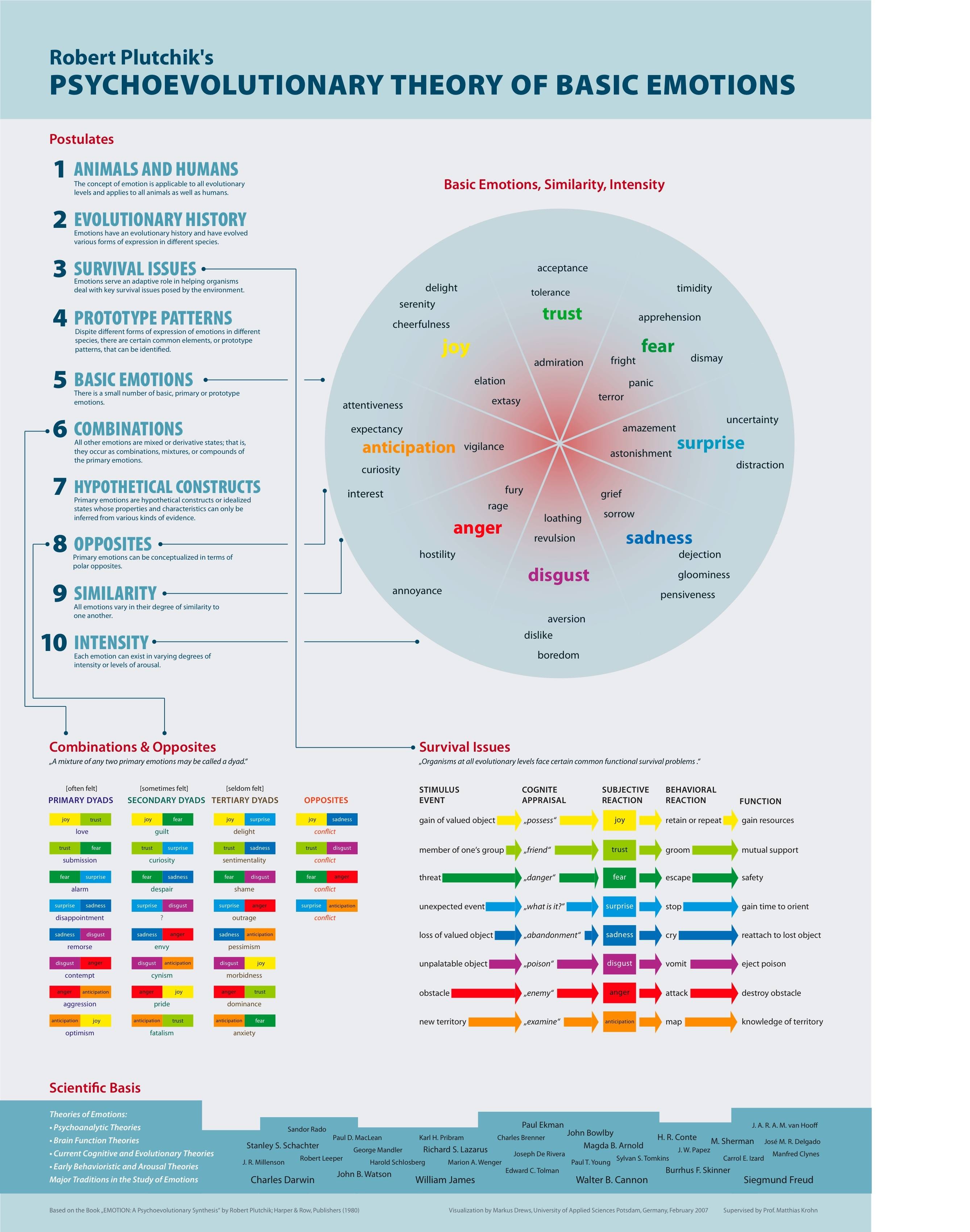
What's in a format?
Thank god for that, a few of you have started the ball rolling and submitted briefing formats.
We need a whole load more and from every corner of the globe.
Just got my mits on Naked, M&C and BBH's formats. We now need briefs from places like AMV, Mother, Wiedens, Goodby, Crispin Porter, 180 you know the kind of thing. We also need briefs from some tip top digital agencies - Glue, Dare, Poke in London come to mind - it would be interesting to compare and contrast these with agencies from a stronger advertising tradition. And how about briefs from design agencies, sales promotion and PR?
Saatchi & Saatchi - London
This is the new naked brief format we are working to. Essentially is a blank sheet of paper with a nice logo at the top and the idea is that you write you brief from the heart rather than filling in a form.Download file.
Fallon - London
This is Fallon's brief - look at how lovely and naked it is. Download file
And here is their Red brief - for re-briefs and pitch briefs. Download file
BBH - London
A powerpoint version of the BBH brief.Download file
M&C Saatchi - London
This is the briefing format I have been banging on about, Download file. Interestingly this is now a little dated and they no longer use a briefing format. Up the revolution.
M&C Hong Kong/APAC
This is the brief from last year as M&C have dispensed with a format here as they have in London.Download file
Modernista - Boston
M! creative brief format. Download file
Testardo Redcell - Poland
A classic format from my old network. Download file
Naked
Naked's naked brief Download file
Euro RSCG Australia
Singleton Ogilvy & Mather - Australia
Oomph - Cirencester, UK
Sudler & Hennesy - Sydney
Impact BBDO - Dubai
Tullo Marshall Warren
McCann Erickson - Indonesia
Here is their official brief Download file. And here is an personal approach from one of their plannersDownload file.
What's in a format? Call for entries.

Kurt Cobain's death certificate. To my mind most creative briefing formats certify the death of the thinking. Image courtesy of Night Star Rominus.
I have an issue with creative briefing forms.
I think they encourage form filling and no agency I have ever worked at has used one. However, even I get a little misty eyed at a good one like M&C's first page or BBH's big red proposition box so I thought we might collect them. Then we can all see what each other are up to in a nice sharing caring kind of way.
So here is the idea.
You email me the creative briefing format you or your agency uses. Just a blank one is fine though you can always send a complete brief if you want and you think that is OK.
I create a new post with thumbnails of all the formats and a link to download each of them.
You can send me your agency's format in complete confidence of course, although if you do want a name check or link that's fine too. Having banged on about M&C and BBH I'd love to get my mits on those in particular.
Any format is fine word, pages, powerpoint, keynote, jpeg or PDF.
And together we build the world's largest co-created repository of creative briefing formats for the benefit of all of us.
Here is the email address
Strategies from the edge
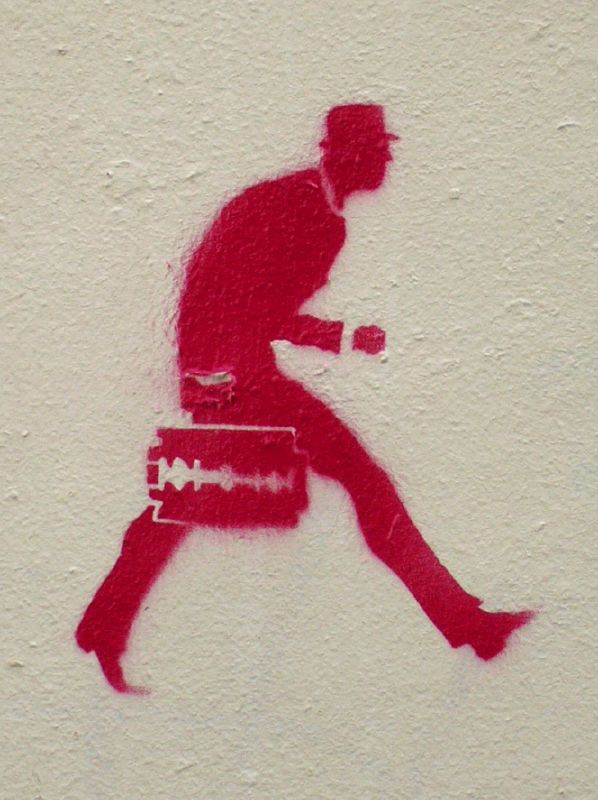
Image courtesy of What What.
I don’t like the word edgy.
Edgy is appallingly overused in our business to describe work that that is uncomfortably unconventional.
We used it one hell of a lot at HHCL. Work wasn’t edgy enough, was really edgy or was way too edgy, depending usually on whether you were a Creative Director, a planner or a client. Indeed at one point one of HHCL's clients used to talk about (and I kid you not) ‘the cliff of OKness’ to police our edgyness. Needless to say we were always accused of presenting work that careered off the ‘cliff of OKness’ like Roadrunner. Our idea for Tango of a group of children born to mothers who drank Tango during pregnancy who roamed round towns giving unsuspecting passers by wedgies was unsurprisingly deemed too edgy.
And I am so over it. Like the term talkability, which has become similarly moribund, it is tedious and its use these days is largely restricted to the terminally short of thinking desperately trying to justify a shockingly washed out grade or a piece of music penned by someone on the sex offenders register.
Edge on the other hand is something completely different in my book. And I am not talking about the aging Irish musician here.
The Edge is where the best creative strategies can be found. Because the edge is at the furthest reaches of what is acceptable, what is possible and to an extent what is true.
The Edge is where you find the behaviour or attitudes of a small number of people that might be made into the behaviour or attitudes of a large number of people. The Edge is where you find deeper insight because it is place you will uncover the real reason why people do some things and not others. The Edge is the place where the strategy everyone fears lives, the strategy that might just nail your problem.
The Edge, frankly, is a place that most creative strategists rarely venture, content as they are with tired insight and humdrum thinking.
And my advice for any strategist is go to the Edge as often as you can. Or at the very least start at the edge, you can always come back in if the initial results are unpalatable.
On toilet tissue we started with the nature of disgust and why bodily substances are a source of disgust. With an electrical retailer we started with the role of electrical appliances in the emancipation of women, on coffee we started with the effect a whole load of Europeans stopping drinking ale and being permanently pissed had on the progress of mankind.
This is the reading, thinking and questioning that will have you branded a strategic freak by your colleagues but it will be the place that you find your genius. And then you can work you way back in to a place where you can sell your thinking to your agency and your clients.
Go hug the Edge and beat to a bloody pulp the next person you meet that uses the word edgy.
Look at the strategy on her
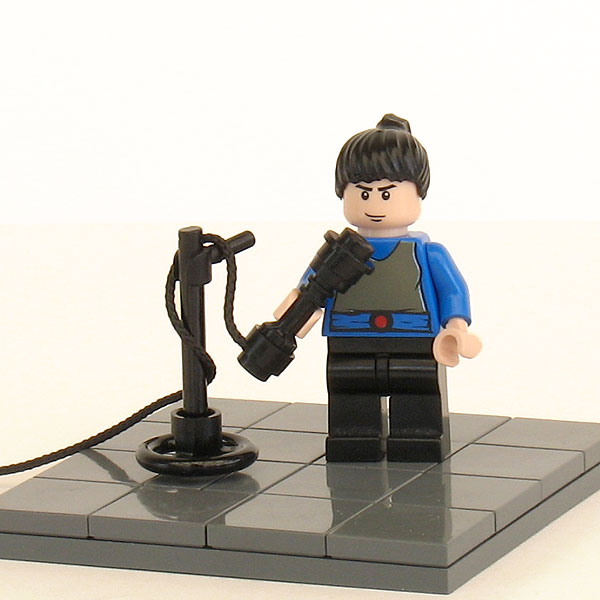
Image courtesy of Mainman.
Droga 5's The Great Schlep idea has been doing the rounds recently as one of the smartest and most engaging political campaigns in a Presidential election that is dripping with smart and engaging political campaigns.
But I thought I'd lob my two penny worth into the fountain of adulation for this piece of work.
Of course I love the execution of this film but I love the thinking even more. At Saatchi we have a little tool we use to help make our strategic thinking rigourous and potent. It goes by the name of an OIIC, or rather Objective, Issue, Insight and Creative Challenge. And this activity makes rather a nice OIIC.
Objective: To help Barack Obama win the US Presidential election
Issue: Key swing states like Florida will make the difference between winning and losing and although the Jewish community prides itself on its liberal values there is one place where this is anything but the case - the swing state of Florida.
Insight: The one group that might be able to influence the Jewish vote in Florida are the electorate's grandchildren who are adored by their grandparents.
Creative Challenge: Ask liberal Jewish grandchildren to convince their less liberal Jewish grandparents to vote for Obama
Idea: The Great Schlep
Rarely do we see such locked down strategic thinking in this category, thinking that has every chance of working because you can trace the idea back to the source objective. Something that can rarely be said of most viral/digital/cool stuff.
It's genius.
Hope it works.
Hat tip to Paul Silburn for the clip.
Here is Jackie Mason's response.
Planning's mid life crisis

Image courtesy of stoopidgerl.
Only planners would have spent the summer celebrating their 40th birthday. Unless I am very much mistaken, the creative fraternity aren’t given to marking Bernbach’s marriage between art directors and copywriters or account handlers to commemorating the launch of Microsoft Excel for Windows. But the Johnny-come-lately of the advertising community has always felt the need to prove its contribution and to celebrate its survival.
And indulgent as it may have seemed, this bout of navel gazing gives us a clue to why planning has survived so long. Like anyone wrestling with a mid-life crisis the greatest thing that we planners fear is losing the youthful exhuberance of the discipline and settling down with a pipe and slippers to a life of comfortable predictablility.
The truth is that becoming part of the agency furniture is not just the greatest testament to planning’s success over the past 40 years it is also its greatest threat. It is precisely the point at which planning is taken for granted that real planning dies and those around it lose the will to live. Planning that is ordered up by clients and dished out by agencies for the simple reason that it is now part of the process on both sides. And planning where the principle output is not better work but acres of powerpoint created purely to serve that process. This is not planning, it is no doubt handy, but it is not planning.
You see planning has survived and prospered for so long for one reason alone. Not because we are part of the furniture but because we are utterly dispensable and we are at our best when we know it.
Only a fool would suggest that you need planners to create powerful and effective work. Not only was our business famous for delivering immensely powerful and effective work long before planning arrived on the scene but it also authored some of the most admired strategic ideas of all time. From ‘We’re number two, we try harder’ for Avis to Stella’s ‘reassuringly expensive’, both safely in the can before planning was even a twinkle in the eyes of Pollitt and King.
The only reason that planning was created and continues to have value is because when it’s good it increases the likelihood of producing powerful and effective work. If it is doing this then it has a potent role in the agency and a right to be part of its future, if it isn’t then it is probably time to pension the planners off and spend your money on a few more Swedish creative teams.
So forgive us our mid-life crisis, it is simply because planning, unlike the other disciplines, is only useful if it is being useful.
Everybody still wants to work at Wiedens
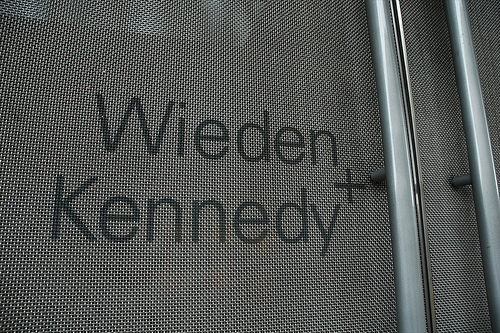
Image courtesy of Kenny & B.
Ohhh look we've gone researchtastic.
Hot in the heels of the IPA Strategy Group's UK strategy community research comes the forth annual Global Planners survey from Heather LeFevre. Of the 798 participants surprise surprise the place planners most want to work is Wieden & Kennedy (apart from 'where you are' which came top in the survey).
Next up is Naked followed by Crispin and Ideo (neck and neck), BBH, Anomaly, Goodby, Fallon, Strawberry Frog and then Google.
Both Chiat Day/TBWA and Mother are out of the list this year.
The full results are below (best to download from slideshare if you really want to get stuck into the data) including loads of interesting stuff on gender (yes that issue, see my previous post), ethnicity of planners (white), presence of children (none), and loads on salary.
Oh and some stuff that contradicts the IPA read on how happy planners are. I reckon thats because the IPA survey is of the UK only and planning rocks here, so line up that visa and phone up your UK headhunter plannerkind!
Happy Strategy

The default disposition of strategists. Image courtesy of Traci Bunkers
According to new research by the IPA we are overwhelmingly happy with in our jobs and optimistic about the future.
The IPA Strategy Group (membership required to view link) surveyed 166 strategists in the UK communications industry. You can read the debrief for yourself below but here is a flavour of the results.
Jon Steel, John Grant, Jeremy Bullmore and Stephen King emerge as the most respected figures in the business while the more inspirational writers include Jon Steel again, plus Adam Morgan and Russell Davies.
We now have quantified proof that strategists are bleeding heart liberals since our favourite newspaper is the Guardian by a very long way.
We are an experienced bunch with 75% amassing over 6 years at the strategic coal face and 45% having spent more than 10 years in the business.
We are an overwhelmingly happy lot. 95% of us say we love the job of being a strategist and 91% of us take a strong pride in our work. 87% feel valued by our clients and 81% are very strong advocates of the profession. So that feels rather positive doesn't it?
We are also reasonably optimistic with 65% of us seeing the profession changing for the better and the place of strategy being assured - 55% of us think clients value strategy over the other agency disciplines. Moreover 40% believe strategists are more likely to get the top jobs in the industry .
All good stuff however there are probably one or two issues that the community needs to start thinking about and that the Strategy Group will begin to address.
1. Gender
While the ad agencies seem to have an even gender split in their strategists others are far more male biased. And taking the community as a whole there are startling differences in the ambitions and aspirations of male and female strategists. Women love the job but many don't really see themselves as in it for the long haul and are more likely to think about going client side. Under a third of women would consider going it alone compared to half of men thinking they might like to start up one day (very few start ups feature women in the starting line up and even fewer feature a female strategist - I am struggling outside MT in the UK). And even more worrying, women are more likely to feel undervalued and underpaid. In comparison men are far more optimistic and confident about their future role in the industry. Is this make bullshit? Is it simply symptomatic of business as a whole and not isolated to advertising or strategy? Or do we have a problem here?
2. Time
The main obstacle to successful work is seen as time and the time to do really good thinking. To a certain extent we have started to tackle this in the Strategy Group through projects like the Fast Strategy Conference.
3. Experience
Strategists in this survey felt most confident in their understanding of marketing, branding, creativity, market research and that kind of thing - the core skills of the planner. However as a group we are much less confident in the areas of digital, direct marketing, data planning and that kind of thing. and we are downright weak in terms of our experience of sales promotion, PR and design. To this end the Strategy Group is designing an programme to help planners understand the role of strategy across the major marketing disciplines.
Here is the debrief in full.
Even faster strategy
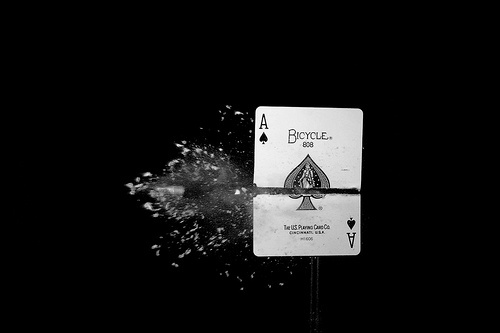
Image courtesy of Liquidrosephotography
Monday this saw the IPA Strategy Group's fast strategy conference here in London.
All in all a rather splendid occasion.
The high point was the victory of the marvellous Richard Storey in a live head to head fast strategy challenge from the UK Government on Dog Registration. It was a good reminder, if anyone needed it, that Richard is one of the most accomplished creative strategists in adland. The Planning for Good team (Mark Earls, Jon Leech, Ian Tait and Chris Forrest) came second and were outstanding, if not quite as sharp as Richard's M&C team (here is the wiki they built that morning to help them). CHI was rather out-classed and brought up the rear.
Anyway, the event made me think about my top tips for getting to strategy fast so I thought I'd share them with you. I've done 17 since it seems such an unfashionable number. Some stuff will be familiar to regular readers - but when you are creating fast strategy it doesn't do to reinvent the wheel.
1. Time is not the problem in creating strategy, ideas are. If you can find an idea the time will find itself.
2. Ideas first, facts second. Facts only make sense in the light of an idea.
3. There are only two criteria for judging your creative strategies - are they simple and are they interesting.
4. It is vital to be interesting, it is merely important to be right.
5. If you look in the same place as everyone else you will never find something interesting, no matter how clever you are.
6. Every great solution comes from a great problem. Make sure you understand the problem behind the problem that you are trying to solve.
7. Anything and everything can help you. Take a walk and think about how every shop, sign, ad, conversation and observation might help you solve the problem.
8. Be prepared. Keeping reading the weird shit.
9. Keep your focus on finding out the things you didn’t know you didn’t know.
10. Call upon your latent strategies, the strategies that you have always wanted to use but have never had the chance.
11. Remember that the stale strategic idea of one category is the ground breaking step forward in another.
12. Jam with other people, online or face to face. But don’t engage that trojan horse of mediocrity, the brainstorm.
13. Ask yourself what the brand’s position might be about the something we all care about.
14. A position is an opinion. We live in an age of conversation and opinions are the lifeblood of all conversations.
15. Plan from within. How do you feel about the brand, category or the wider world? How do you explain your own behaviour? You are not unrepresentative, you live in the same brand landscape as everyone else.
16. Trust your instinct - its the most truthful resource you have.
17. Fast strategy is more about decisiveness than speed. Often we need strategic courage more than haste.
The four I's
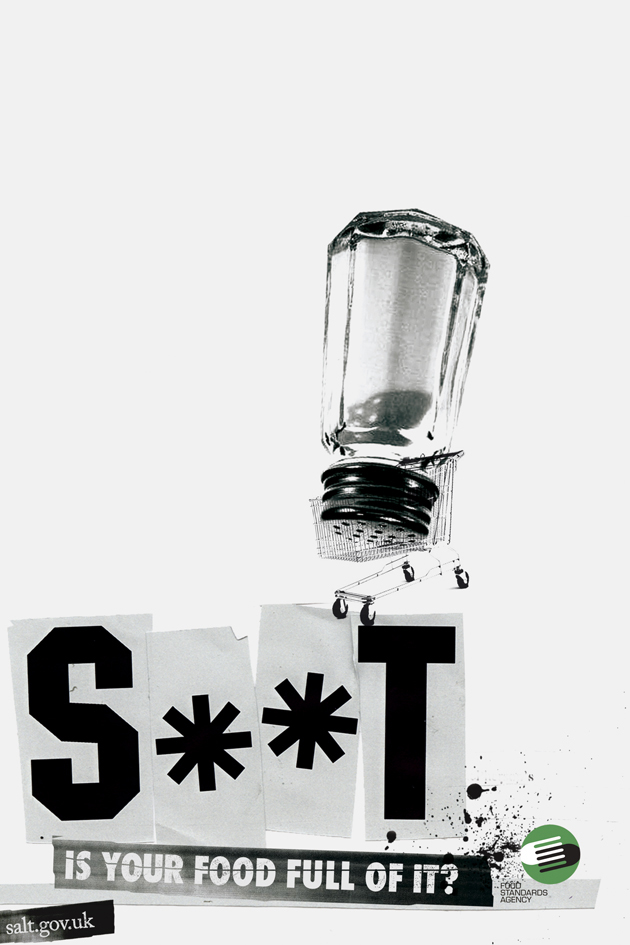
United London's anti-salt campaign from last year. The four I's in action.
I have been giving a bit of thought to a planning approach recently. Something that reflects they way I do it at the moment but nothing too heavy and contrived.
Naturally it involves alliteration and specifically the words ‘interesting’, ‘instinct’, ‘insight’ and ‘idea’..
I guess my professional mantra of late has been summed up in the phrase ‘it is vital to be interesting, it is merely important to be right’.
Strategists spend vast swathes of time desperately trying to be right with the result that the majority of strategic thinking is cliched, lame and dreary. So how about if you tried to be interesting first - to think of the most interesting idea possible for your brand, category or the wider world - and then worked out whether it was right? Or could be made to be right.
My faith in this approach is partly fueled by the belief that there are no longer right strategies anyway, merely ideas that engages people to a greater or lesser extent. ‘Dirt is good’ for Persil/Omo and ‘Turn to 30’ for Ariel are both great brand ideas. As are both Lurpak’s foodie strategy and Anchor’s free range approach
W+K's Lurpak work planned by the genius like Matt Boffey
Anchor from CHI
It is also because you don’t have to go to one of Russell’s conferences to believe that the principle currency of human interaction at the moment is ‘interest’. If that is the case, whether an idea is interesting or not should be the most important measure of how good it is - not the only one but the most important one.
So thats the basic philosophy - find the most interesting thing that you could possibly think about a brand, category or the wider world and then figure out if its right. Simple. It makes what we do both breathtakingly easy and phenomenally difficult - because everything rests on your ability as a strategist to come up with interesting ideas.
I have to say that as the person in charge of strategy at a large agency like Saatchi & Saatchi I also find it the most potent guide in my thinking about the work of other planners. When you are trying to comprehend the quality of thinking on a very large number of brands of which some are more familiar than others, it is incredibly simple to apply the interesting yardstick rather than try and figure out the right answer.
Now, the more I think about it there appears to be a series of stages to developing an idea, by which I mean a brand idea - or the idea behind the brand.
The first is to do with instinct.
Very often if you thing about a project at the beginning of your journey you will have an instinct - something that your gut tells you about the brand or category, or that you have always wanted to do with that brand or in that category. Loads of people think that you can’t possibly start your strategic journey with instinct, well I beg to differ.
For starters you will often understand the brand as a consumer does because you are a consumer. You live in the brandscape and as such your point of view (however representative or not) is entirely legitimate and its a great place to start. In many ways your instincts make the most real insights because they are very personally felt.
More than that, whether you are a strategist that has been doing this for a while or just starting out, you are progressively training your instinct to know a good thing when it sees it (much like the idea that it takes 10,000 hours to get good at something that Russell talks about).
The more you exercise your instinct the more reliable it will become for you.
Finally all this instinct stuff doesn’t negate the need to have a look see what the data (whether qualitative or quantitate) says. A spot of data might be exactly what your instinct need to lick start it.
On the Alcohol Harm Reduction project for the COI the planner an I were reading through reams of Client research and both came across the word Vulnerable. Nothing much more than instinct suggested that vulnerability seemed like an interesting place to start - casting binge drinkers as victims of alcohol in clear and present danger not perpetrators of an terrible social evil. It led to work that talked about the way in which drinking substantial quantities of alcohol made people vulnerable to harm.
That said when it came to relaunching the cereal bar Tracker it was pure instinct that suggested the answer lay in the brand name - Tracker simply had to be about the great British outdoors with it drizzle, kagools and yappy type dogs.
So trust your instinct, ask your instinct what it feels and train it to be perceptive and powerful.
Then use that instinct as the place to hunt for insight. In many ways your instincts make starting points for the most real insights because they are very personally felt.
An insight for me is a new way of thinking about the brand, the category, the wider world or indeed the consumer. A way that is both surprising in its originality but also in hindsight true. Insights are by definition new bits of thinking and nothing upsets me more in the world than tired insight.
On Lotus Freshness (an Aloe Vera impregnated toilet tissue from Georgia Pacific) the instinct was about turning it into Molton Brown or Aveda of loo roll. It felt that no one in the market was stepping up to the changed relationship that we have with our bathrooms, not least in the way the products that we buy for them are now on display because they look so good rather than being hidden in a bathroom cupboard.
That is not where we ended up but was without a doubt the starting point for an insight about toilet roll as part of the skincare market and relaunching Lotus freshness as a skincare brand.
The idea is how you crystallise this insight in a way that is powerful for the brand. At Saatchis this is called the Organising Idea, other places have their own versions of big idea, brand idea and brand ideal. And there is loads of stuff elsewhere on the site about what makes a potent Organising Idea.
On Lotus the Organising Idea became ‘Lotus. Skincare for your derriere’
On Tracker the insight that British families needed to get out more and enjoy the Great British outdoors led to the idea of “Tracker. The rucksack snack’.
On our salt reduction campaign for the Food Standards Agency the idea was ‘Is your food full of S**T?’. This was built from the insight that Salt is a hidden killer lurking inside prepared foods in unfeasibly large quantities. And if you really want to follow it back the instinct was about needing to get really tough about Salt. While it is essential for human life the average British male is consuming 11gms of salt a day against a maximum allowable daily amount of 6gms. The creative team spotted in a moment of God like genius that shit and salt are both four letter words beginning in S and ending in T.
Interesting, Instinct, Insight and Idea - not infallible but not a bad way to approach life strategically.
Naked briefs

La Danaide by August Rodin. Image courtesy of Jahsonic.
It is one of the least edifying characteristics of planning directors that they spend a lot of time creating a new briefing format for the agency or network. It is what my old boss Jim Kelly would call "displacement activity".
I don't know about you but I have never liked briefing formats and forms. The theory goes that if you fill out all the boxes on the funky new template that someone has spent the last six months of the agency's time putting together then you will miraculously end up with a brilliant brief. If only it was that easy.
I have always believed that filling out boxes on a brief reduces the process to something more akin to applying for a credit card and thus regarded the whole briefing form approach with utter derision. But some agencies seem to like it.
Fortunately neither of the places I have spent most of my career (AMV - the UK's largest agency - and HHCL - for a long time the UK's most interesting), had a briefing form. Both places felt that planners should write the right brief for the task in hand.
Lets face it we are all grown ups here and we can all write a brief without the help of some ridiculous form. I tend to write mine using a decidedly simple, decidedly old fashioned structure which I am minded to call the naked brief.
It is naked because the structure is so spare that it directs one's attention to the quality of the thinking and away from the quality of the form.
And this is how it goes:
1. The role for communications. Look mum, no background. Background is usually an excuse to dump a load of stuff that is not important enough to get in the body of the brief but somehow seems like it might be relevant. My advice is to bin the background and get straight into the effect the activity is intended to create. The role should get to the absolute heart of the problem. And when you have nailed it it is still worth asking yourself 'why' a couple more times simply to get to right to the root of the task.
2. Target audience. This is the stuff about the audience that is absolutely relevant to the task. And don't write it in a "Timothy and Samantha are both aged 24 and like to go out a lot, watch DVDs at home and have a very experimental attitude towards sex" unless you have actually met these people and you aren't just making up some ghastly advertising targeting confection. This sort of trite story is the 21st century equivalent of telling the creative team that the audience are ABC1, Men and Women aged 25-44 - the square root of fuck all use.
3. Proposition. Call it what you will but this is what you are trying to communicate about the brand. Propositions work with the role for communications. The role for communications sets the challenge the work must meet and the proposition is the idea that we want to land about the brand.
4. Support. The stuff that convinces you that the thinking can be supported, will convince the creatives and ultimately will convince the consumer. This is not the repository of all knowable information on earth but the stuff that makes the thinking compelling.
5. Tone. Only if it makes the difference and you can elevate yourself above the cesspit of statements like "businesslike but not formal". On Tango briefs I used to write that if the work wasn't so funny that it made you piss blood then the work wasn't right.
6. Requirements. What do we know we have to do. If it is prescriptive then tell the team what the media agency has already bought. If this is a campaign that can achieve its aims by any means necessary then keep it open.
7. Mandatories. This is not the place on the brief to get creative. It is the place to communicate the stuff that is non-negotiable.
8. Creative starters. Use this to road test your thinking and to open up the ambition of the brief. Ensure that a couple are media starters, and if the requirements are open guide the team about the nature of potential solutions - digital applications, events, promotional ideas - whatever it takes.
It's as boring as hell but that is the point. Minimum time spent designing a funky new creative brief and maximum time spent on the thought or thinking that goes into them.
Advice for young planners - Skunk Strategies

Never surrender to lacklustre thinking, always know you have a better idea. Image courtesy of asboluv
I like Skunk Strategies.
Or rather I like them in the absence of anything else. And you might find the approach useful especially if you are working in a difficult sector, on a difficult piece of business or at an un-inspiring agency.
We don't always get to work on dream projects with loads of latitude and the freedom to create the thinking that we feel is the most interesting. This is especially the case at the beginning of our careers or with client organisations or agencies that set their strategic sights low.
So we acknowledge that the confection on the table is somewhat lacklustre in the thinking department, though we are nominally responsible for it. Sure it's no 'positive hate' or 'tolerate mornings' but it's a damn sight better than the original pile of rubbish the client or agency management was determined should sit in the middle of the brand bagel or whatever they happen to be using. And we then reassure ourselves that it is actually quite good for this category.
Everyone can understand why these kind of disappointing outcomes happen. What is unforgivable is when we don't have an alternative strategy under our hats that we love and tried to sell instead.
Whenever I come across thinking that simply doesn't excite me but where there are extenuating circumstances for why the strategy is as it is, I always ask the planner for their skunk strategy. A skunk strategy is that alternative bit of thinking that they really wanted to land. Who knows, with a following wind we might be able to create some new energy around it and even if this isn't possible it is a reassuring sign of professional pride and personal standards.
I heartily recommend this approach whenever you feel that the piece of thinking on the table simply underwhelms you. I mentioned a few skunk strategies - particularly from pitches in the Strategy Safari post I did a couple of years ago.
Incidentally I named Skunk Strategies after an approach we took at HHCL on big pitches. There would be an official pitch team and a skunk pitch team with the later freed from the obligation to follow the pitch brief at all.
When pitching to hold onto the Tango business I was in a skunk team that was concerned with putting the 'orange' back into Tango and used the strategy 'Its the oranges stupid' in honour of the note that Clinton had pinned around the place in the run up to the 1992 presidential elections. One route was based on the observation that Tango contained the whole fruit a bit like economy pies contain the whole pig. The line was "The whole orange from snout to arsehole" and the work depicted the ghastly abattoir where Tango was made. Hey ho.
Here's the Folger's 'tolerate mornings' ad by the way - still think its great.
United we fell
Now that I am safely ensconced in my new advertising home I thought I'd put up some stuff from United London - the short lived but rather fun shop that closed its doors in April last year. While it bore very little resemblance to HHCL, the agency from which it was formed, one of its key qualities was that it retained a ferocious commitment to top draw planning that was one of the reasons that HHCL was so good in its day.
Here are some of the United case studies in the format we used for cred's and using the problem, position, promise and brand idea approach which regular readers will be very familiar with. Like all good case study formats it could really do with a results section.
I thought I'd show them as they are live examples of the way the approach worked in practice. Possibly interesting for planners - presumably as dull as ditch water for everyone else.
Oh here is some nice radio for Tracker - not quite Sony balls but I like it.
Rucksack Snack
Crunch Goo Chew
Map Snack
Springtime
Coherence is more important than consistency
One of the things that I always bang on about without really thinking about it in depth is the idea that Clients and agencies need to place less emphasis on consistency and more on coherence. So I thought I’d worry this one out a bit.
Consistency was the marketing mantra of the ‘90s. Both Clients and their brand advisers would regularly look at the entire creative output from the brand and demand that it be more consistent.
By which they usually meant that it should look the same either in its entirety or certainly within individual campaigns. Direct usually got it in the neck for not looking like it came from the same company as the above the line work, and this heralded the growth in brand literate DM agencies in the early part of the decade.
The philosophy was built around the idea that budgets could be better optimised if all the creative output looked like, in the words of that ghastly cliché so popular at the time, ‘it sang from the same hymn sheet’.
This approach reached its zenith with identity rich communications from brands like O2 in the UK, which delivered religiously consistent work at all customer touch points.
It also manifested itself in geographical consistency, where the same work for a brand was run across all territories. Coke was big into this in the early nineties before embracing a more open approach to creativity. This may well have started out as a way from exercising control over local markets and delivering some production economies but made greater sense as the internationalisation of both consumers and media started to match that of the brands.
Consistency was everything.
The trouble was an emphasis on executional consistency rarely derived from a clear and coherent strategy for the brand. Either consistency was driven out of an advertising campaign devised for specific media or out of an identity that had little to say beyond superficial aesthetic appeal. Surely if it all looks the same and uses the same endline it means the same.
Maybe we are now witnessing a counter trend. One where Clients and agencies are less bothered about executional consistency as long as the brand’s point of view is coherent across media, between campaigns and around the world. Hell the endline doesn’t even need to be the same if it still delivers the idea at the heart of the brand.
Of course this requires the brand to have a coherent point of view in the first place and rather points up those that have a nice endline but no role to play in peoples lives.
I think we can see this approach happening on Dove with the campaign for real beauty. Here we see an astonishingly coherent brand idea being delivered in all sorts of ways to the delight of the audience. The richness of different media and the subtleties of different cultures are easily accommodated because of supreme confidence in the brand idea.
The added bonus of this shift in priorities has been the improvement in inter-agency relationships and collaboration. Individual shops are far less likely to be asked to copy the work of another agency and more likely to be given the core idea and asked to do the best possible work in their medium or their market. The lead agency is still the one that devised the idea but that position is less likely to be used to stifle the role of others. Who is the lead agency on Dove? Well its not entirely clear form the outside and just for now Ogilvy in Toronto is making the most celebrated work.
There is a view (actually I stole this from Dr Joe Plummer and have manipulated it to suit my own ends) that coherence is the name of the game now because audiences are no longer congregated by media so that the same group of people are drawn together at the same time and place to witness the same content on the same platform. In a world of congregation everybody is seeing everything so it makes some sense to make it all look the same. But if audiences are increasingly aggregated from different groups of people witnessing different content from the brand at different times and on different platforms then executional consistency becomes both less possible and less desirable
Against that backdrop it is rather sad to see Bravia doggedly pursuing an extremely unedifying approach to their work seemingly built entirely on consistency rather than coherence. So while moving image advertising uses all the power of that medium to deliver colour like no other, none of the other media are allowed to do this. Instead they must parrot the TV work to the point where they cease to be ads for Bravia and become little more than ads for the ads. I’m sure there is a bloody good reason for this but as far as I am concerned ‘build awareness of the advertising’ is rarely a legitimate communications objective.
I think that’s what this consistency versus coherence thing is all about anyway, but as ever maybe its something you would help me build upon.
Battle of Big Thinking
If anyone is interested I have uploaded my speech from The APG's Battle of Big Thinking as well as the slides.
For regular readers many of the themes will be very familiar.
Image courtesy of Wikimedia.
A short story about provenance
I recently enjoyed an evening at Leith's cookery school in well heeled Kensington.
All in all a very good evening matching wine to food even if I stood out like an ad man at a posh cookery school wine tasting night.
Anyway, there was rather a fascinating story about accessibility, commodification and provenance that I thought I would share with you, my brand loving friends.
Image courtesy of Rune T
One of the real secrets of the New World's success in the global wine market (especially in less confident territories like the UK) was the simple act of naming the wine according to the grape variety. This is a trick that had escaped the Old World producers that have been busy creating regional or estate brands whaich are hideously confusing to the average drinker.
The actions of New World producers has been to build powerful global grape brands like Chardonnay, Sauvignon Blanc, Pinot Noir, Cabernet Sauvignon, Shiraz, Merlot and Zinfandel. All of a sudden less confident drinkers found it easy to work out what they liked and were able to recognise a favourite grape wherever they shopped or drank. Old World wine remained as impenetrable as ever.
The wine market became more accessible and opened up to new drinkers encouraging an increase in production. Superb.
Except there is now oversupply in the global wine market and this is hitting the New World producers hardest forcing down their prices. This is because their product has become commoditised - anyone can deliver the Chardonnay brand or the Pinot Noir brand so down comes the price at which you can sell yours. To an extent there are country brands - New Zealand Sauvignon Blancs, Californian Zinfandels, Chilean Cabernets but that’s it.
Meanwhile the Old World producers are sitting a little pretty because while anyone can produce a Cabernet Sauvignon only producers in the Medoc can produce Medoc and only Chablis produces can produce Chablis (a Sauvignon Blanc). They have steadfastly continued to build brands they could retain ownership of, massively insulating them from rampant commoditisation.
Hurrah for micro-provenance.
Many a slip twixt pre-prod and playout
I have long believed that a planner's job must continue right up to the playout of an ad - not just working on the client's business but working on the ad itself.
For me a planner needs to be hold onto the project whilst it is in production and post production right up until the clock number is allocated.
I call this continuity planning for some inelegant reason.
Of course we need to be careful about this. It is a more passive role at this stage, if you are a control freak during this part of the process you will never allow the craft disciplines the space and freedom that they need to make the work executionally perfect. As David Ogilvy was so fond of saying "why keep a dog and bark yourself".
And I have never been that convinced about planners attending shoots - contributions at that stage are neither appropriate nor useful and, as with everything else, should have been covered off in the pre-production process. Of course on some projects planners might wish to be at the shoot simply to preserve the team dynamic that will have built up around a major peice of work.
All of that having been said, if we believe that the body language of communication is as important as the message (if not more so) then planners cannot absent themselve from this critical stage, as the work takes shape. And, while there is rarely a place for a planner on the set there sure as hell is in the edit suite and sound studio.
A neat illustration of the difference made by tiny post production decisions came my way very recently.
Searching on YouTube for Wieden Amsterdam's imaculate Nike Air Max commercial (featuring Johnny Cash's version of NIN's Hurt) I came across and alternative edit.
First remind yourself of the ad that played out - still gets to me every time.
Now consider the alternative edit. I think we can assume it was a real option, even if only for a nano second since it is from the Mill.
I was stunned by the difference simply treating the footage with a consistant sepia tint has made.
Theoretically it makes sense if you are using borrowed footage from a number of sources to treat it all in some way. Firstly to improve the visual consistency of the film and secondly to add a 'look' that will help cut through and attribution.
And yet in simply changing the 'grade' every single drop of emotion is bled from what was a deeply emotional film. By removing the visual authenticity of the original athletes going through real physical and emotional pain it takes on the artificial look of something that was shot for the occasion.
Of course you don't need a planner to realise this, far from it. Any good team will have given it the treatment a go in the edit suite and backed away - which is surely what happened here.
But it makes you realise the way that one tiny decision in post can make the difference between the success and a failure of a piece of communication.
And if it doesn't work because of that decision then for me the planner still has to take responsibility - better to have been there in the first place.
Genius doesn't have a sell by date
There are a number of things happening this autumn to commerate the life and work of Stephen King the co (and coincidental) founder of the planning discipline (along with Stanley Pollitt).
My efforts have been focused on the inagural Stephen King Strategy Agency of the Year Award in November but the APG is also launching a collection of Stephen's writings on the 1st of October.
So it is time to get acquinted or re-acquainted with the great man's work - whether from this post, by buying the book from the APG or rocking up to the book launch. If you want to go to the latter (£50 including a copy of the book - loads of lumanaires are going to speak so get your planning director to cough up) email the APG pronto here .
I've started with an internal JWT document written in 1974 enigmatically entitled 'Planning Guide' and it's golddust. Thanks (or as I believe the bloggers say 'hat tip') to the chaps at Staufenberger (via Russell) for access to a PDF. You can down load it here.
Not so much a schooling in the fancy dan stuff we now get up to but a breathtakingly concise overview of the way brands work and how planning can help advertising to make them work better.
And of course its way out of date...not.
Given this is 1974 we are talking about his view of planning is frighteningly contemporary.
He insists that planning must stimulate imagination and creativity rather than just provide controls and disciplines.
He refutes the idea that creativity is ever 'a sensible, logical, step by step process'. And he means the planning part here not just the 'creative'.
He is right up there on the need to understand that it is not what is said that is important but how people accept and interpret the information. And he questions the whole idea of messaging.
He advocates woking in project teams with high levels of collabration and people moving out of their rigidly demarcated area of skill.
And he nails the coffin tightly shut on the idea that you can pre-test work because you can never prove a hypothesis is right in advance only prove that it is wrong.
And this leads to King's big obsession, Karl Popper's "hypothetico-deductive" process in which hypotheses are advanced and then subjected to a disciplined attempt to disprove them. Only when the attempt to disprove an idea fails can you accept it with a degree of confidence.
Pretty full on stuff because I can't honestly say that I have ever come across this kind of rigidly disciplined approach in the cut and thust of ad agency life. Inevitably every fibre of our being inclines us towards trying to justify why an idea is right rather than advancing it because it can't be proved wrong. I guess it is only within IPA effectiveness papers do you see a "hypothetico-deductive process" being used to show that there is no other adequate explanation for the claimed advertising effect.
Ladies and gentlemen its time to spend time with the King.
Delicious insight ahoy
Led Zeppelin are reforming for a one off gig at the O2 in London on November 26th, so far 20 million people have tried to get a ticket.
And here is another thing I never thought I'd see it in my lifetime.
An insight in a razor campaign. I'll leave it to you to discover but it's one for the dad's (like me) out there.
It's not perfect executionally - the writing might be tighter, I'm not sure it needed it need the movie trailer construct and it is a bit of a game of two halves. But fight for kisses is what I'd call a 'we will all be in Berlin for tea time' brand idea.
Nice one JWT Paris.
By the way the fight for kisses site is here. I couldn't download the game successfully maybe you will have more luck.
What happens after we collect the underpants?
A friend reminded me this weekend me of a clip from South Park in which the underpant gnomes are stealing all the underpants from the town. This is stage one in a three stage plan in which the third stage is to make a huge amount of profit. The problem is that there is no stage two.
How redolent of the vast majority of advertising campaigns.
Heres the clip (or not - obviously the makers of Southpark have had it removed from You Tube).
Time and time again one sees clients and agencies with an accurate and complete picture of the business problem they need to solve and an advertising campaign they think might solve it but with no understanding of the way in which the advertising will work to deliver those results.
They know that stage one is to advertise and believe that stage three is profit but they are largely clueless about stage two.
In a way this shows a rather endearing belief in the power of advertising but it is also one of the reasons that advertising gets marginalised within an organisation - even within a marketing department. Sure, time and energy are spent pitching the ad account and working with the agency to deliver the work but no one seriously believes that its really going to deliver so meanwhile efforts are redoubled elsewhere (particularly in direct) to ensure that the business results are delivered.
It's one of the reasons that many clients now see their ad budget as ornamental rather than instrumental - it makes everyone feel good and provides some air cover for the rest of the business but it's not there to deliver real, tangiable and immediate results.
This problem is exposed most clearly during ad pitches when clients are often extremely clear about what needs to happen in the business - the problem that they face. However, they rarely spell out how they believe that advertising will help deliver against this (perhaps feeling that this is an answer they are looking to agencies to provide) and they rarely seem to commission work that will actually solve the problem.
You can also smell it in weak agency briefs. You know the kind of creative brief that waffles on endlessly about the 'background' rather than spelling out the role for communications in meeting the business objective. This is one of the reasons that I insist that creative briefs don't carry background but start with a clear idea of the problem and our expectations for the way advertising will affect it - a model for the advertising if you like.
And beware the creative presention that whitters on about talkability, fame, cut through, and all that malarkey for it is a clear sign that the creative director doesn't understand how the work is going to work either.
Everyone working on a campaign but most especially the planner must have a clear idea of what will happen once all the underpants are collected. My feeling is that few do.
Everybody wants to work at Wieden

A push pin rendering of Wieden's Fail Harder ethos. Image courtesy of media bistro.
Despite the Nike bombshell and a recurring sense that Dan's 'I'm just an old hippy' routine is wearing a bit thin, Wieden + Kennedy is the plannersphere's ideal agency to work for. And with work like Old Spice and Honda, and that lovely blog, who can blame us.That's according to new research amongst planners conducted by Heather LeFevre of the Martin Agency which places Crispin Porter at number two, BBH at three and Chiat at four. Goodby comes in at five, with Fallon (London surely) and Mother sixth and seventh. Of course the forthcoming APG Creative Strategy awards will give us a chance to see whether this lot are actually up to much in the strategy department.
Heather's work, which surveyed 466 planners (42% inside the US and 38% outside) also tells us that 41% of planners think that the standard of planning is increasing (for which blogs get some of the credit Mr Lowery) and that while 60% of us really like or love our jobs, many of us are up for a move (suggesting that being a planner is fab but not necessarily at one's current agency). And in a result likely to upset Mr Stolkin around 70% of people didn't get their current job using a recruitment consultant.
There is also loads of detail on salaries (just for US and UK owing to the samples sizes elsewhere) which offers you a chance to benchmark your remuneration or indeed to decide to move to the US or UK. I note that 12% of the heads of planning describe their package as 'really awesome' so there is something for the rest of you to aspire to.
For the full monty download the PDF here.
Google is the daddy
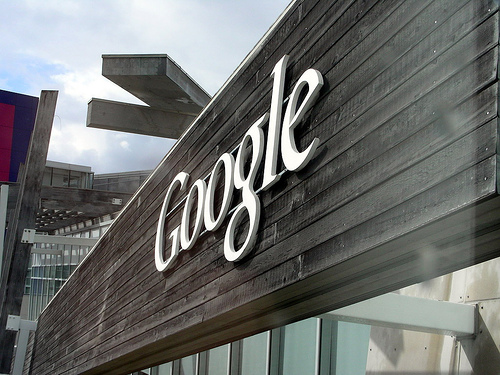
The Googleplex, home of the world's most valuable brand. Image courtesy of Keso.
According to new research from WPP released this week, and to which adliterate was given a sneek preview, Google is now officially the most valuable brand on earth - at $66,434m ahead of GE, Microsoft and Coca Cola.
This is the second year that WPP and Millward Brown have produced a ranking of the world's most powerful brands (using a methodology that is markedly different to other brand equity studies), however it is the first in which Google has reached the top spot.
And yet more proof, if it were needed, that while brands always win the speed at which the brandscape is being rearranged at the moment means no-one can be complacent about their position in peoples' hearts, minds and wallets.
For the brand valuation geeks I have summarised the WPP approach but you can always cut out the middle-blog and go straight to the study here.
WPP's methodology uses three stages to determine the global value of a brand.
The first thing they do is to isolate the intagiable earnings from the brand by taking the global corporate earnings that are attributed to the brand name in question, these are the branded earnings. Then the intangiable earnings are derived by removing applicable taxes and a capital charge.
The second stage is to calculate what portion of those intangible earnings are driven by the brand - the brand contribtion if you like.
This is the share of income that comes from the most committed customers (not from people who buy purely on price or other soley functional criteria). To do this they use the % of customers that are bonded to the brand or for whom the brand has advantage, as derived from WPP's BrandZ study. This is critical because it means that you are not simply giving a value to the brand name but to the emotional power the brand has.
Finally a number of weighting measures are introduced like presence in high growth economies and the brand's voltage (this is what I call brand potency - essentially how dynamic the brand is and therefore how likely to grow in the future). This stage provides a multiple that favours brands that have positive momentum and are in the right place.
This leaves you with the global valuation of the brand, simple as that.
Here are the top ten brands.
Of course we could debate the philosophy of trying to add a value to an intagiable concept that lives entirely in people's minds but that's annother post.
Blogging and planning - enough already

Image courtesy of MrTruffle
I am bored witless by the 'is blogging killing planning?' debate now -it isn't, end of story. But in a pathetic attempt to have the last word on the matter here is the very short opinion piece I did for UK ad bible Campaign.The idea that blogging is killing planning is arrant nonsense. The main accusation is that it encourages people to share half thought through thinking. Well no shit, in a 2.0 world where you should always be in Beta test, this is the whole point.
The plannersphere is not a journal of record for the science of advertising it is a place where we try out our new thinking for the first time. It is a place where a planner like me can submit half-baked ideas to the collective intelligence of the online planning community for their scrutiny, contribution and improvement.
And it is a place where a planner from any part of the globe, can gain access to the best thinking in our discipline and support from a global community of planners.
Blogging isn’t killing planning it’s the best thing that has happened since the death of the overhead projector.
Right, now that is settled lets get on with embracing this wonderful new world. And how better than with Drew and Gavin's Age of Conversation project to which I am contributing a chapter as are many of you.
Please think generously

Image courtesy of Sagasurfer.
Much of my time is spent at the moment thinking about the nature of brand ideas - how to build them, and critically how to spot whether what you have got is good enough.
To date I have been unable to create a fail safe ready reckoner for great brand ideas - although regular readers will know I have a very particular approach to building them.
The truth is that there is no process that you can follow that will churn out great brand ideas, you just sort of, have to have them. And please do not be fooled by charlatans that claim to have a special product, process or workshop to generate these ideas, any hardware is only as good as the software that runs on it.
However, I think that there is one thing that is absolutely true of great brand ideas - they are generous.
I don't mean generous to their customers, though this is always nice, but generous to the other organisations collaborating on the project.
Generosity is clearly not the be all and end all but when you brief your partners (whether creative, media, digital, PR, instore or anyone else) if you can see them literally salivate at the thought of the work that they are going to be able to produce...
If the moment they understand the idea, they can already see that it will show off their prowess, allow them to meet the expectations the client has of them, give them a great case study and make working on the project enjoyable...
And if what you have is a proper 24 carat brand idea not just an advertisinng conceit or an executional flourish then you are probably onto a winner.
One gets a real sense that the people that have got to work with the campaign for real beauty, in whatever field, have got to produce the best work of their lives. That is a generous idea.
Short commerical break because I love this online ad.
Now, you make think is all decidedly wet. But I assure you it is a shortcut to knowing whether what you have is any good.
Of course it helps if this generosity of thinking is matched with a generosity of spirit - a little humility goes a long way. It may be your idea but it will only live with their enthustic delivery.
So please think genersously.
The data dump
 Image courtesy of cutangus
Image courtesy of cutangus
One of the great criticisms of the plannersphere is that it is data shy.
So here are three lovely charts for the data hungry amongst you to feast on.
First up, a chart on media fragmentation and proliferation, sent to me by Dan White at Millward Brown. The original source is unclear so if you know where it came from I can do due attributional diligence.
The image has degraded rather alot so if you like what you see download it here
Second a lovely bit'o'data from Daniel Joseph at TBWA/London. Make of this what you will.
By the way radio relates to all commerical radio and I suspect we should treat this stuff as directional only. It is nontheless interesting.
And finally something from the data meister himself, John Lowery, and stolen from his blog, almost nothing. It shows the number of customers for key brands, that do not have access to the internet at home. Looks like they are all Grey clients which is interesting because it is a very mass market bunch of brands - stops us all thinking everyone out their is Nathan Barley.
By the way you have got to love slide share - sheer planning heaven.
Orwell's message to plannerkind
I'm rather enjoying George Orwell's 1984 at the moment. Loads of stuff to ponder on including this rather wonderful passage that seems tailor made for my argument that quantitative research in marketing represents little more than quantitative speculation. Is appears in the section where Winston Smith is fabricating the Ministry of Plenty's figures so that their forecasts rather better resemble reality.
But actually, he thought as he adjusted the Ministry of Plenty's figures, it was not even a forgery. It was merely the substitution of one piece of nonsense for another. Most of the material you were dealing with had no connection with anything in the real world, not even the kind of connection contained in a direct lie.
Bear that in mind in your next quantitative speculation debrief.
Rather more profound, though, is an other quote, one with direct relevance to our day to day business.
Orthodoxy means not thinking - not needing to think. Orthodoxy is unconsciousness
Let's try to remain in a state of consciousness as we develop our strategies and ideas rather than zoning out and settling for the orthodox and unthinking.
Perhaps we might all carry a bottle of smelling salts that we waft under each others' noses whenever we get tempted to write strategies like 'the beer with a clean crisp taste' or 'the family saloon that thinks it is a sports car'.
Is blogging killing planning?
 Image courtesy of MrTruffle
Image courtesy of MrTruffle
There is a mood abroad, often fostered by non-blogging planners, that the emergence and popularity of planning blogs is killing the discipline.
I certainly feel that the community, like all communities, has begun to coalesce around specific 'new marketing' ideas that are in danger of becoming an orthodoxy every bit as dangerous as the antiquated ideas about brands and communications that it is seeking to replace. Specifically it encourages a view that the marketing landscape has already reached a kind of utopian future without offering any clues about how brands and the clients that own them should get there.
But is blogging really 'killing' planning?
This topic first came up in an email from Grey planning chief John Lowery, who raised his concerns about the potentially corrosive nature of blogging.
"One thing I noticed as I hyperleapt from one planning blog to another was an almost total lack of quantification of anything anyone said, at all. To that extent I thought perhaps one could make a case that blogging is killing planning, or at least planning as I know it. The publication of baseless pontification has, it seems, been democratised and offered up as a glamorous new role-model to a whole generation of 'planners' who wouldn't know what a tracking study questionnaire (not to mention an awareness index) was if it bit them in their left hemisphere".
And I have certianly heard a version of this arguement at Coffee Morning, particularly from planners like John Griffiths. His concern is specifically that the pannersphere looks like a brilliant training resource but it fails to discuss or encourage the development of core craft skills.
While I do have some sympathy with this view (most notably that the content of planning blogs tends to be around the more 'out there' thinking that we do in our day to day jobs), after nearly two years and just over 100 posts I can't help thinking that blogging is the best thing that has happened to planners since Moleskine notebooks.
So in a spirit of 'what has blogging ever done for us' here are the reasons I think it is important for our discipline.
1. Community and networking
Blogging has created a planning community online (I call it the Plannersphere) that provides introductions and builds close ties within the discipline based primarily on the commodity we value most highly - how people think. And while this community is strongly represented in traditional planning industries and territories, where considerable mutual support already exists, it obviously works for those planners that work in places where our kind are rather thin on the ground. Whether they are in industries outside advertising or countries outside the planning hotspots. Indeed as a bunch of people who often shy away from traditional networking and schmoozing it has filled a very valuable need amongst planners.
2. Beta testing thinking
Every good planner thinks constantly about brands and communications, but unless this has direct and immediate relevance to their accounts it goes no further than an internal dialogue or idle banter with planning collegues.
The Plannersphere provides a place to crystallise and air thinking for others to build on or contest before it is aired more formally. But more than that it represents a group of people that are interested in your brand thinking no matter how rudimentary, people that encourage you and drive you on.
3. Collective intelligence
I reckon we are getting smarter as a result of the plannersphere. In nearly 20 years in the business I have never experienced as much intellectual stimulation and intense conversation as I have over the past 18 months - both because of thinking that exists on line and offline stimulus that it has led me to. New ideas, however ill formed at first, spread with ferocious speed at the moment making you aware of all sorts of thinking and giving you the ability to contribute to it. Transmedia Planning from Faris and Brand Enthusiasm from John being two clear and very recent examples.
4. Training and education
OK so the plannersphere isn't hot on the craft skills, although it is interesting that Russell's Account Planning School of the Web has gone back to basics more recently to try and respond to this criticism, but the plannersphere is incredibly successful at knowledge sharing. On a daily basis seriously good people are falling over themselves to give away their intellectual property or simply share a new campaign or brand they are interested in. It may not be providing the 3 Rs of planning but you'd be a fool if you were starting and you weren't consumming your body weight in wisdom from selected planning blogs.
More than that, by showcasing thinking at its very best we can help to teach emerging planners the standards that are expected of great strategic thinking beyond the approach or expectations of their current environment.
5. Influence and profile
Planners rarely hug or hog the limelight - I guess we are just built differently to your average account handler or creative. I have often joked that it is only planners that blog in advertising because account people have nothing to say and creatives have better places to say it but maybe its more that blogging was built for us. Creatives have their work and by and large that speaks for itself, account handlers their client relationships and the revenue they sit on or win but planners never really had much of an outlet to show how good they were (although the APG and AAAAs Jay Chiat awards have helped). Blogging has given us planners a way to show we are good and create influence within our agencies, the broader community and potentally with our clients.
6. Effortless internationalism
After years on international business stubbornly failing to understand anything going on outside the M25 I love the way that blogging makes you instinctively international as a planner. You see work from around the world easily and without cost, you are read throughout the world (albeit shamefully the blogs I read in return are English language) and your comments come from people throughout the world. In an industry that has always had a ugly strand of national arrogance running through it (particularly in the UK) blogging and the tools we use to bring our blogs to life (like you tube and flickr) are pulling down national barriers in the communications business.
As far as I am concerned, the plannersphere has created a kind of intellectual soup for a global community of brand thinkers to feed off, contribute to and create value from. As such it is and has the power to significantly improve the quality of planners and planning in the brand advice business.
For my money blogging and planning are a marriage made in heaven.
(P.S.) Since I wrote this I have been pointed at Hugh's thoughts about what makes a good blog. Seriously worth a read.
Russell and Richard
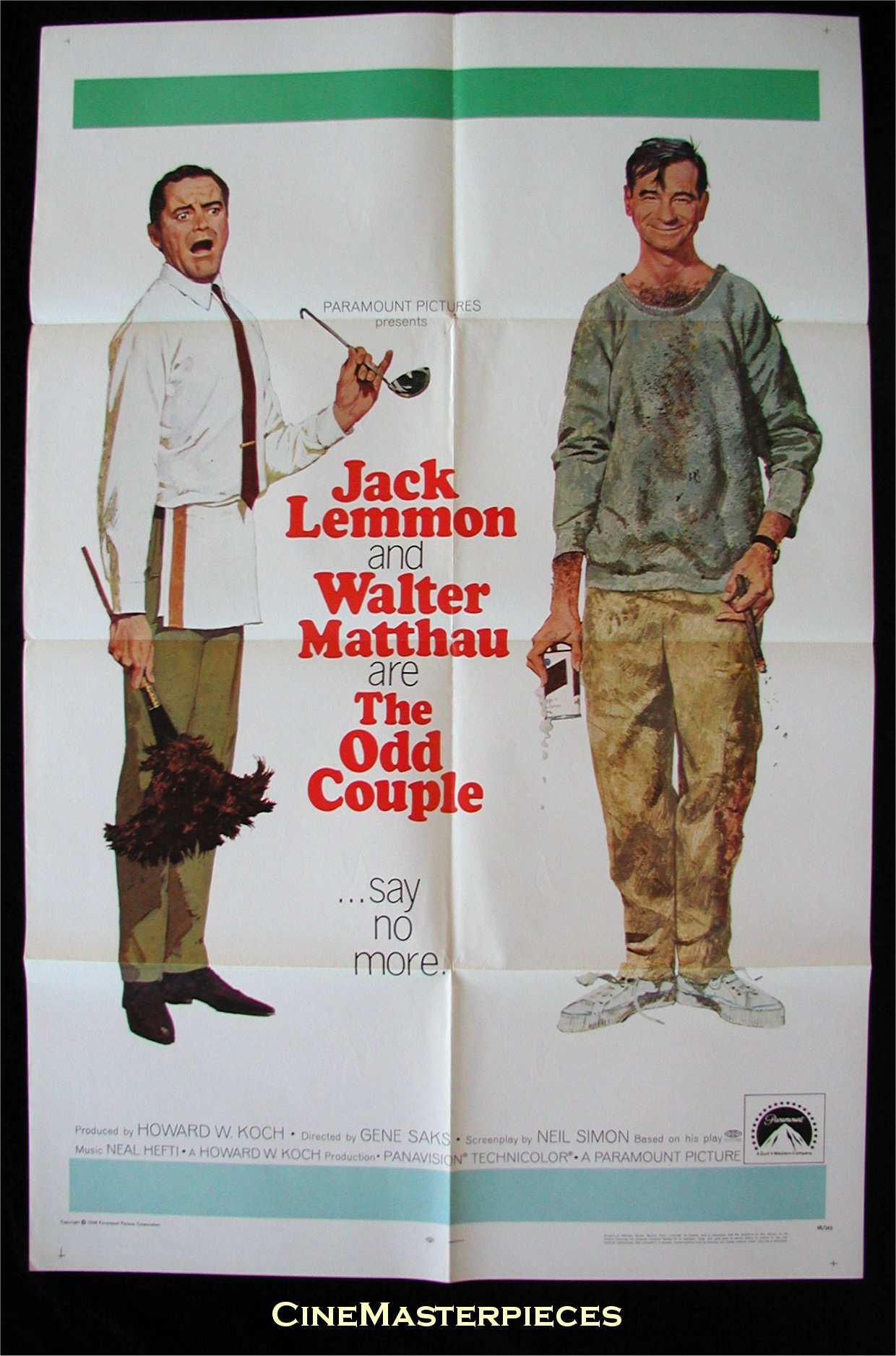
Russell is a gent and he has done me the considerable honour of posting part of an inteview he did with me here . While the second session is here . To be honest I think the first one is rather better but you be the judge.
In a way I am finding that these interviews help hone my thinking better than posting to the blog - hope you can find something of use in here.
Building better brand ideas
I had wanted to create a definitive set of criteria for judging whether you had a proper brand idea or not. But this exercise wasn't particularly fruitful - or at least I think its tough to try an legislate for strategic genius. And indeed as decent a list as any was included in the post I wrote about Jon Steel's Perfect Pitch - truth, beauty, excitement, significance and persuasion if you remember.
But I really like this chart - it sort of fell out of the conversations.
The problem - I am a great believer that great ideas start with big problems. And the more fundamantal the problem the better. This has always been my defintion of radical as taught to me by the great Jon Leach - radical means solving problems at their most fundamental level - or root (hence radix or radical) cause.
Your position - this is about showing that you care about the things that we care about. It is partly taken from the Cluetrain idea that people are no longer interested in your positioing only your position and partly from John Grant's idea that brands need to find a bigger enthusiasm to have. Dirt is good is about finding a bigger enthusiasm than detergent. I'm pretty keen now that all brand strategy this more opinionated approach.
Your promise - I think this is an important part of the mix. The promise is the way in which you (implicitly or explicitly) prove to the consumer your credibility in holding that position and what you intent to do about it. Implicit in the dirt is good position is the promise that Persil will get your kids' clothes clean no matter how dirty they get.
Your Brand Idea - This is an outward facing crystallisation of the postion and promise ideally exploiting the tools and tricks of edibility, memorability and transmission I am so keen on. Dirt is good works because it is bold, contrary and based on a familiar structural form. Critically this cannot simply be an idea that the brand has had but should be the idea behind the brand - or as Adrian commented, the brand ideal. Don't confuse this with an advertising idea or a creative idea. These can come out of the brand idea (and great brand ideas should yield great communications in the right hands) but they are unlikely to be the primary manifestation of the brand idea.
Incidentally there should be afollow up chart to show the way then that the activities of the brand should explode out from the brand idea creating the molecular structure Grant talks about.
Simple as that really.
Why are brand ideas so rare?

The Black Rhino (Diceros bicornis). With a population decline of 98% between 1970 and 1990 there are few animals more critically endangered than this.
Of all the beasts roaming free in the world of marketing there is none so rare as the brand idea.Given that every agency is convinced they build big ideas for their clients on a daily basis, real brand ideas are surprisingly thin on the ground.
Of course there are notable exceptions and many of those have been duly noted and celebrated in this forum - 'Dirt is good', 'The campaign for real beauty' and even 'Try something new today'.
And our business folklore is built around ideas like 'We are number two, we try harder', 'Reassuringly expensive', 'The ultimate driving machine', 'Its good to talk', 'The fourth emergency service' and 'The power of dreams'.
But by and large most brands and their agency advisers appear consummate in their ability to avoid coming up with genuine brand ideas - settling instead for advertising ideas or worse, just a one off creative idea.
This wouldn't be a problem except that it leaves countless brands and businesses without any point and with no reason to exist. Whole swathes of the financial services market, the high-street and mall, online retail, automotive and fmcg are packed to the gunnels with pointless brands - simply because of a lack of intelligence and imagination.
The problem, I suspect, is that no-one has the slightest idea what a proper brand idea looks like. How can you deliver the holy grail of brand marketing if you can't tell whether the ideas you have come up pass muster.
That is what we are going to do in the run up to Christmas ladies and gentlemen - create a set of evaluation criteria for brand ideas.
Now I am reasonably certain the whole thing will make use of the Cluetrain idea that people are no longer interested in your positioning they want to know what your position is (seems to me to be the way Dirt is goods is working'. Indeed as Hugh says - the market for something to belive in infinte.
And I think generosity is going to play a part somewhere. I don't mean showing generosity to customers (though that is nice) but creating ideas that are generous to everyone that works with them. That's one of the characteristics that separates a proper brand idea from an advertising idea - it doesn't matter what discipline you represent you immediately know how to execute excellent work to 'Dirt is good'. It is generous because it allows everyone to excel.
And there must be some way of evaluating potential ideas on the basis of perceived potency - though I'm not sure how to frame that yet.
Do you have an idea about what makes a great brand idea?
A ready reckoner for great ideas
He in turn distilled it from a quote in Physics for Poets by Robert March.
"A scientist...is supposed to be looking for the truth about nature. But not all truths are equal. Some we call deep truths, and these are the ones that are also beautiful. An idea must be more than right - it must also be pretty if it is to create much excitement in the world of science. For the search for truth is not simply a matter of discovering facts. You must also understand their significance and them persuade others that your way of looking at them is valid. It is always easier to persuade people to believe in something new when they find it beautiful, especially if it runs counter to their established beliefs".
It is a little light on the 'bugger me I had never thought of it that way' dimension but I guess if I were excited about an idea it would be for that very reason.
Ladies and Gentlemen - more beautiful thinking please.
Our debt to Dawkins
Richard Dawkins seems to be the hit of the moment in the plannersphere.
In particular Wistlethroughyourcomb has an excellent post on the Selfish Gene (Dawkins's legendary first book) and its lessons for viral marketing. Meanwhile I am gleefully enjoying his latest book - The God Delusion. Basically it is a call to arms to aetheists to stand up and be counted for the moral majority we certainly are in the UK, if not sadly elsewhere. The first half of the book essentially questions the existence of a God while the second attempts to figure out what it is that has led humanity to believe in a God. After all as an evolutionary biologist he must explain while religious behaviour has survived if it superfluous to our existence - otherwise natural selection would have favoured the irreligious and religion would have died out long ago. I owe Dawkins a great debt. Firstly in helping me realise my agnosticism was spineless and secondly for the meme idea and the thinking that he inspired about memetics. Many people have taking this idea far further than Dawkins and in particular I find Dr Susan Blackmore by far the most inspiring. One of the most wonderful ideas she has is that our minds are constantly rehursing our memes - and that she uses meditation as a way to silence the little buggers, if only momentarily. As a rather mediocre addition to the debate I wrote a paper a decade ago called 'here come the meme doctors' that argued for the marketing community to replace the word brand with the concept of memes and you can download it here. And specifically it was his essay about religion called 'viruses of the mind' that created this understanding. In using religion as the uber meme he demonstated the characterisitcs that great ideas require if they are to be successful. And thus he forged the analogy between successful ideas and viruses that is now ubiquitous in the marketing community. All great ideas or memes are viral and behave virally, infiltrating the host, replicating and infecting others, not just the silly little films which Clients and agencies call virals. Here are a couple of pointers that reading all of this stuff has reminded me about creating powerful ideas. Great ideas need to serve a purpose We tend to forget that ideas need to be useful to people, not just the products or brands they are associated with. Most controversially it maybe that they help resolve fundamental contraditions between the reality of our lives and our expectations. I have argued elsewhere that the Apple meme helps us deal with the way that the new economy is only accessible to a select few and the majority of people still have to struggle on in McJobs as oposed to Mac jobs. Apple helps resolve this by selling us a slice of new economy identity. So it may be that an idea resolves a contradiction like this or it may be that it's appeal is not to us so much as our memeplex - helping reinforce and extend it. A memeplex that gives as well as takes. Great ideas work best when they are part of a supportive memeplex. In other words memes are reinforced by other ideas that surround them. I think this is how 'dirt is good' is working. Alone that idea is interesting but inherently contestable, however the reality is that it operates as part of a memeplex that currently includes 'kids spend too much time watching TV', 'kids are increasingly obese', 'childhood is too short these days', 'we have become over protective of our children', 'litigation culture is damaging our childrens' childhoods' and the like. It draws currency and strength from cooperative memes. Hence the popularity of cultural ideas in the planning world - a brand's position rather than its positioning - that locate the brand in an area people already care about. Great ideas need to have copying fidelity - in other words they are capable of being passed on accurately and without deterioration. One of the issues Dawkins addresses in the God Delusion is the idea that the way some memes are constructed with self correcting mechanisms - so that we kind of know if there has been a mistake in replication. I rather think that this is why the aphoristic form is so powerful in communications, and why I am supporting the renaissance of the slogan. The rhythm, rhyme, alliteration or assonance of a great slogan not only help memorability but also provide a self correcting mechanism. Compare the latest Argos line 'don't just shop it, Argos it' and the line it is based on - 'Don't just book it, Thomas Cook it'. Both are saying the same thing but the form of the latter helps you remember it, communicate it accurately and the rhyme has a self correcting mechanism that makes you realise if it has been communicated inaccurately. If we can build ideas that serve a purpose over and above the performance of the product, ideas that play to, are imbedded in and extend a memeplex, and ideas that have copying fidelity we have all have a fighting chance. And I reckon we will have Dawkins to thank.
However, you can't separate our understanding of the way ideas (and here I am using the terms ideas and memes interchangably) are created, built upon, absorbed, remembered and passed on without acknowledging that Dawkins is the daddy.The truth about great planning
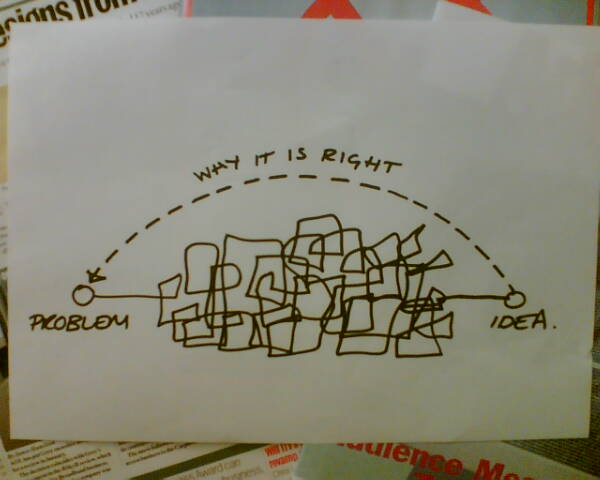 "Theory cannot be fabricated out of the results of observations - it can only be invented" Einstein
"Theory cannot be fabricated out of the results of observations - it can only be invented" Einstein
Universal advertising formula
Whose job is it to sell?
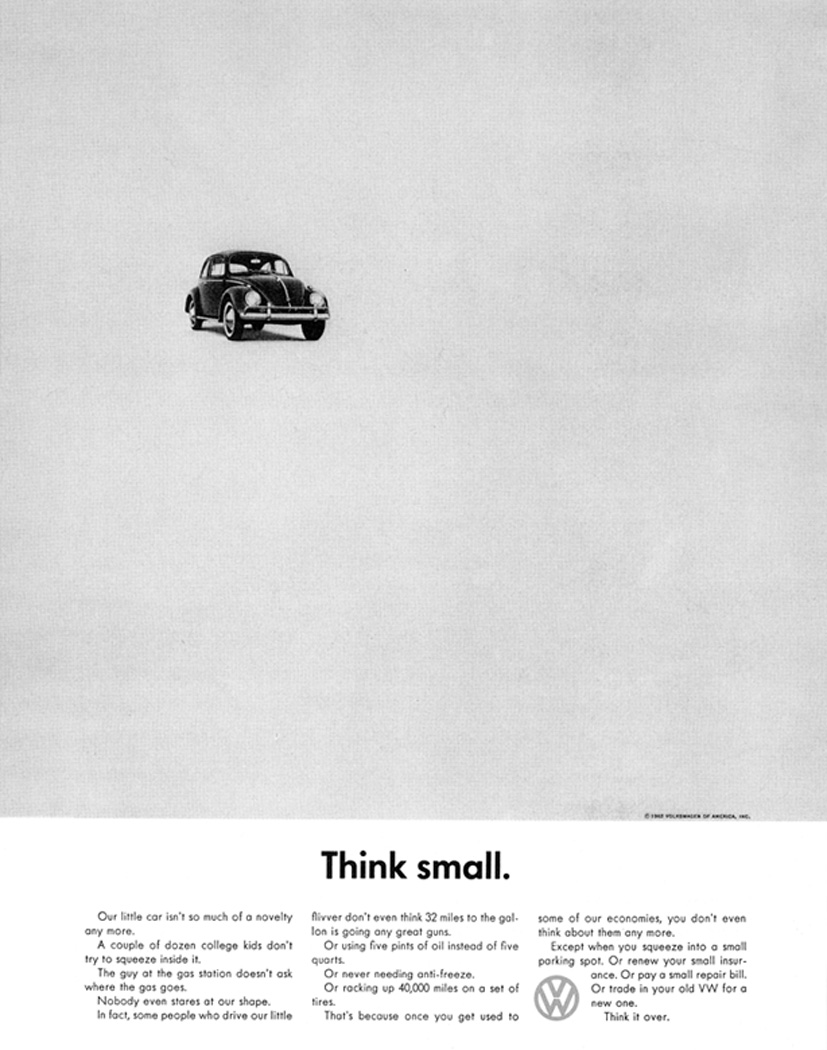
A planner asked me recently who Bill Bernbach was.
I said that “he invented advertising and the fact that you don’t know who he is should be a fireable offence”.
Of course this version of events isn’t quite right but along with David Ogilvy he certainly pioneered the discipline of creative persuasion – a form of salesmanship, yes salesmanship – that I am worried is being lost.
Few people in advertising really want to sell any more, least of all the creatives who used to be at the heart of the process.
Creatives have been progressively deskilled in the art of creative persuasion.
And we did it. Planners took away the role that creatives had in thinking about how a product or brand should be sold to consumers and left them to do the colouring in, or rather to dramatise other peoples’ selling ideas. Planning killed the selling instinct of the creative salespeople in advertising. Or maybe planners became the creative salespeople in advertising.
Or maybe they deskilled the creatives and didn’t properly fill their empty boots but instead minced around claiming to be the voice of the consumer or worse some kind of inspiration tool for creative teams.
So I am suggesting both a new role for planners and a new role for creatives. As you have come to expect its an extreme point of view designed to provoke you lot.
I think that planners (or half decent planners) are the natural airs to the legacy of Bernbach, Ogilvy and Abbott not the creatives. It is their job to devise a brand’s sales promise to the consumer and to prove the brands delivery against this promise. It is the planner’s role to be the salesperson. The planner is tasked with effectiveness.
This frees creatives up to present the promise and the proof in the most compelling way possible. The role that creativity plays is as the media multiplier that converts £X of ad spend into £Y of effect through attention, engagement, transference of meaning, memorability and desire to disseminate. In this world the creative is tasked with efficiency – getting more effect out of limited budget.
For all you delicate creative flowers out there this may sound like a mechanistic view of creativity but that is exactly the role that Juan Cabral, the Fallons creative on Sony Bravia is playing. Even though the paint on tower block ad is still in post production it has already generated far more conversations on and offline than the TV budget with ever deliver on air. That is the creative media multiplier at work. Let only hope that the planner has depth charged this work with a strong sales message.
So let’s embrace the new division of labour within the ad agency. Let’s here no more mumbling about creatives creating art not ads(being artful is their job) and lets stop planners hiding behind consumers or shooting the breeze with creatives rather than working.
Planners sell, creatives multiply.
Better advice for young planners
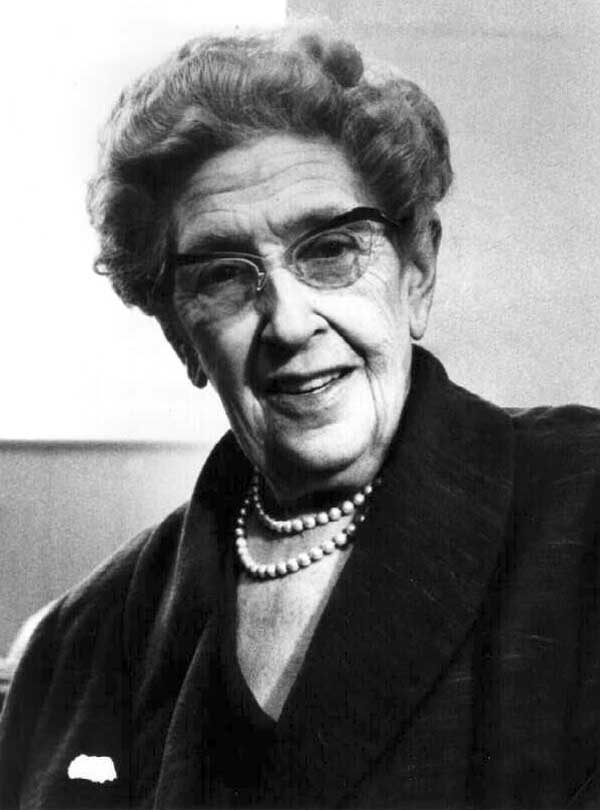 "Good advice is almost certain to be ignored but that is no reason not to give it" Agatha Christie.
A while ago I posted some advice for young planners that I contributed to a Romanian advertising blog. It got a few mentions out there and a nice person from the US called Stacy asked if she could use it to send to client agenices in the US - she helps train planners in smaller agencies. And I got a bit self conscious since the advice I gave was rather thin. So I have updated it - a few more pointers and a lot more context. Of course you don't need to be starting out to find it useful but I wouldn't want to be that presumptuous.
"Good advice is almost certain to be ignored but that is no reason not to give it" Agatha Christie.
A while ago I posted some advice for young planners that I contributed to a Romanian advertising blog. It got a few mentions out there and a nice person from the US called Stacy asked if she could use it to send to client agenices in the US - she helps train planners in smaller agencies. And I got a bit self conscious since the advice I gave was rather thin. So I have updated it - a few more pointers and a lot more context. Of course you don't need to be starting out to find it useful but I wouldn't want to be that presumptuous.
1) See the world differently to everyone else
I think great planners are wired a bit wrong. What I mean is that they can be subjected to exactly the same stimulus as normal advertising people but come out with a totally different response. There is a lovely quote about scientific discovery that it is about “looking at the same things as everyone else and seeing something differently”. And that’s what we do at our best. When Stuart Smith at Wiedens sat listening to Honda’s chief engineer say he hated diesel engines it was because he was wired wrong that he saw a genius strategy for Honda Diesel in ‘positive hate’ rather than simply experiencing an agreeable talk from an engineering legend.
2)Try to be interesting first and right second
I think planners spend too much time trying to be right – to come up with the right answer regardless of whether it is interesting to them, the creative team or the consumer. I think it’s a much better plan to try and find the most interesting thing you could possibly say about the brand or category and then work out whether it is right or could be made right with a little tinkering. Markets are conversations and so brands need something to say that people find interesting. Above all fight cliché in any form.
3)Plan from within and then see if other people are like you
I plan from within by which I mean that the first thing I ever do is sit down and think about what I think about the brand or category. In particular I try to find a point of contact with the brand – maybe I use it already so why? Or maybe I don’t use it so why not? Or maybe I used to use it so what went wrong? This is the best source of genuine insight (though it doesn’t always work) rather than the superficial assumed insight that floats at the top of your brain and every other advertising person that walks the planet.
4)Read weird shit it always comes in handy
Planners need to draw from a massive pool of inspiration and the more eclectic the better. This pool allows you to make the weird connections that I talked about in point one and fashion the analogies I will talk about in point 5. By all means read the trendy business and planning tomes of the moment but do not do this at the expense of the weird shit. For one thing everyone will have read the business and planning stuff so there will be no competitive advantage for you in doing this. The weird shit on the other hand will be the source of your idiosyncrasy and the freshness of your strategies.
5)Speak in analogies - the more bizarre the better
Plato considered the metaphor the highest form of human intelligence, so do I. Now don’t get me wrong I am not advocating analogy advertising as a creative solution (it is usually terrible) merely that your prodigious use of analogy will help everyone around you understand where your head is at. It is evidence of your weird wiring. Just keep your analogies fresh, nothing upset the writer George Orwell more than ‘dead metaphor’.
6)Always know you had a better strategy
Just as creatives often see great ideas be rejected often to be replaced by lame and lacklustre work so will you. I will entertain the excuse that the client or the agency management or an unambitious creative team are the reason the thinking is a bit pedestrian but only if you have a work of minor strategic genius up your sleeve that they rejected. I post mine on adliterate in a category called ‘Strategy Safari’.
7)Collect strategic ideas
Generate brand thoughts and strategies constantly. For the business you work on, for the business you would like to work on and for the business you will never work on. This does two things, it keeps your ‘hand in’ during periods where you are making work rather than generating ideas and it builds up a stock of latent strategies that make you faster in creating an idea when a pitch or project for that brand or category finally comes into view. I also advocate creating a ‘book’ much like creatives do, of all your thinking. This will be invaluable when you want another job because it proves the way you think. Blogging it is even better.
8)Always think and communicate clearly – radical doesn’t mean complicated
There seems to be a conflict in the ‘plannersphere’ at the moment between those proponents of simple, but lets face it often dull, thinking and the advocates of complex, but they argue more interesting, thinking. I reject both camps – the more radical thinking is often very simple and easy to express like ‘pre-tuned by German engineers’ for Crispin Porter’s Golf GTI campaign or ‘the fourth emergency service’ for the UK’s leading breakdown company.
In anycase your first job as a planner is to master clarity, brevity and simplicity in your thinking, briefs and presentations. Only when you have mastered the craft should should you ‘pimp’ your thinking.
9)There is always a problem to solve – find itIn his latest book, ‘The Brand Innovation Manifesto’ John Grant points out that “Good ideas start with the realisation of a problem to solve but much mediocre brand marketing starts with the idea of ‘advertising a brand’ as if it were a business objective in its own right”.
Our business works best solving problems and there is always a problem if you look hard enough. Half the task is to isolate the right problem because if you do there is actually a chance that the solution you propose will work. Wrong problem, wrong solution – no results.
10)You are a salesperson first and foremost – everything else is just technique
Never forget that planners, like everyone in advertising, are salespeople. We specialise in the art of creative persuasion – everyone of us. And your job is to work out how to sell your client’s brand or service. Engagement, direct response, big production budgets, media placement, music, new media, humour, product demos, and frequency whatever – they are just techniques to sell and all of them have their place. Remember David Ogilvy’s mantra “We sell – or else”.
The strategy cow

My eldest son has this toy. It is a cow (I think) which normally stands erect but when you push the base upwards it collapses. It perfectly describes how I feel when I come across lacklustre or cliched thinking - flacid, deflated and lacking in the strength to perform simple tasks like standing up properly. From now on I will submit the strategies of the moment to the Strategy Cow for her to pass judgement. In addition this service is offered absolutely free to you dear readers - simply submit a strategy of the moment to the Strategy Cow and see what she thinks. By the way following no popular demand whatsoever the Agrarian Ajudicator has set up shop here
Coke Zero
Great product, great packaging but what does the Strategy Cow think of the thinking - 'All the good with none of the bad'?

HP
Man in a panic submitted the new HP work to the Bovine Ajudicator with its thought that 'the computer is personal again'.

Good news Panic. She loves the ads too.
Adez
A correspondent writes that the launch strategy for this juice drink is apparantly "Lets stay strong". Over to you cow.

Ohh a shocker - Strategy Cow says its smells of a substance she frequently produces from her rear end.
Toyota Yaris
Apparantly the new Toyota Yaris is a small car that thinks its big, or its the small car that is big on the inside or some such iteration of the oldest and most boring car strategy in the known universe. Anyway it is not for me to pass judgement, that is the sole perogative of the intergalactic head of strategic grazing.

Nil points from the fresian jury.
Lenor
I couldn't find the ads that were refered to but I did find the lenor website and the idea that 'the pleasure is all yours'. At first I was really keen to see this as a 'dirt is good' idea but alas no. Just read this twaddle from the site "In these time-pressured days, the idea of taking time-out just for you can seem like wishful thinking and any attempts to simplify your life may be easier said than done. However, Lenor recognises that even by making the process of doing the laundry easier and more pleasurable it can allow you to free up a little more precious time to do the things you really enjoy and to re-charge your batteries". That is the 'Birds Eye is the bird of freedom' idea from the 80s(ohh look quick and easy frozen food means I can spend more time playing badminton). Grow up.

And the uddered umpire agrees too. When does she get to review a strategy that restores her to her fully upright position?
Ribena
Apparantly Ribena uses up almost all of the UK's Blackcurrants to make their tots squash. And, in the belief that this is a)a good thing b)interesting and c)a platform for preference, they have decided it should be their strategy. This despite the fact that it is not normally considered that monopoly is a good thing (see Microsoft) nor that it implies any sort of discretion in the selection of product ingedients. John West didn't say 'we hoover up all the fish we can lay our hands on willy nilly regardless of quality' they said 'its the fish John West rejects that makes John West the best'. Frankly I think that would have been a rather more desirable approach and a way to justify Ribena's inevitable premium over own label. Moreover its not like Ribena have had to fight tooth and nail to lay their hands on all those blackcurrants - there is no other commerical use for our least desirable indigenous soft fruit. I'm afraid the strategy cow's view is:

She adds since this is an M&C campaign her final and singular word on this is "indiscriminate".
It really is this easy
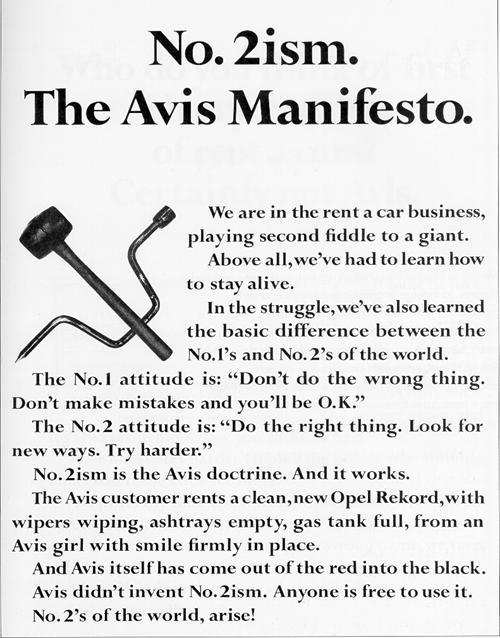
I have been re-reading the Clive Challis book about Helmut Krone - Bernbach's legendary art director. It reminded me how much better it was in reality than in my head. I encourage you to look beyond the cliche of 'we try harder' and engage again with the strategy and more importantly the execution of this campaign. This is advertising at it's most effortless, most engaging and most persuasive. And look no logo - the best branded campaign in advertising history had no logos in it big or small. Advertising really can be this easy if we stop getting bogged down in irrelevant strategic discussion, stop navel gazing, stop living in fear of the future and get back to the basics of creative persuasion. See you on the barricades
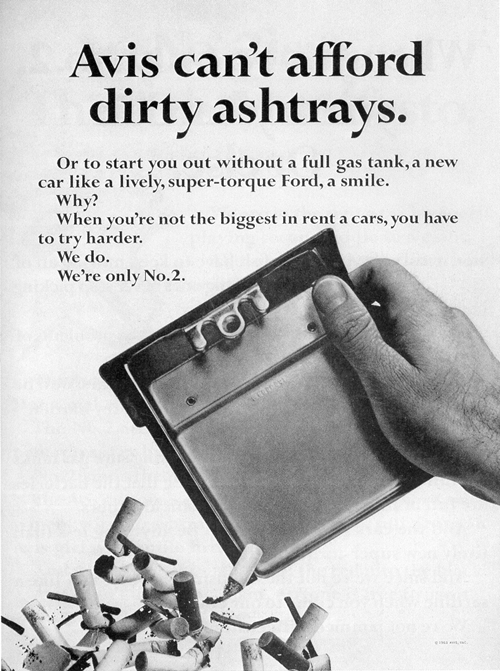
The problem with bad planning
Dirt is good

I took part in a panel discussion at the IAA European Advertising summit this week along with Jim Carrol and Rita Clifton and chaired by the great John Grant (who gave me a copy of his excellent new book 'The Innovation Manifesto'). We had to talk about our favourite European campaign. I chose Persil's 'Dirt is good' despite the tragic creative work in the UK. I feel that this bit of thinking really hasn't had the fame that it deserves which saddens me. This is the kind of thing that I said. Image courtesy of KoAn
I have chosen this ‘Dirt is Good’ for Persil in order to be deliberately contrary.
I hate the ads. They are cheesy, trite, woefully lacking in any insight and horror of horrors they are by and large vignette ads. As we all know vignette ads are what creative teams wheel out when they can’t think of an idea.
But I love the strategy.
Planners like me get proposition envy when we come across thinking that we wish we had come up with. And this campaign makes me feel sick with proposition envy.
It also neatly illustrates a number of themes I am currently warming myself on.
This is a category that for decades has been seemingly incapable of creating communications with anything interesting to say. Against this backdrop of whites being washed whiter and brands with a new kind of bluey whiteness Persil decides that the arch enemy of detergent advertising throughout the twentieth century is actually its best mate. And ours too.
Persil believes that dirt – providing that you can effectively eradicate it at the end of the day – is a wonderful thing, evidence of creativity, adventure, exploration, endeavour and curiosity.
If we believe that markets are increasingly conversations then I maintain that every brand needs an opinion because opinions are the lifeblood of all conversation. And this is a full on brand opinion – evidence of a brand talking about its position not just its positioning.
And while it hasn't yielded very good advertising in the UK, dirt is good has had a sensational effect on the other parts of the communications mix and informs every part of Persil's conversation with its customers.
As part of its brilliant online presence Persil hosts the ‘United kingdom of dirt' (accessible through the link to the main dirt is good site) where the activity of the month is currently hunting for worms
Persil’s sales promotion activity is built around dirt is good – at the moment you can collect proofs of purchase for school art materials.
It works in PR with specially commissioned research into play malnutrition that suggests that child development is now at risk because of the decline in messy play.
And it even extends to Corporate Social Responsibility where Persil works with organisations like British Cycling and Learning through Landscapes to promote outdoor play and leisure.
This thinking is a work of mild genius and I love it.
Yet more proof to me that there is no such thing as a low interest category only low interest thinking.
Advice to young planners
I was recently interviewed by a Romanian advertising blog called iqads. Amongst other questions they asked whether I had any advice for young planners and I thought I would share this with a wider audience. They are short, sweet and incomplete.1) See the world differently to everyone else
2) Try to be interesting first and right second
3) Read weird shit it always comes in handy
4) Speak in analogies – the more bizarre the better
5) Even if the thinking that you are forced to go with isn’t the most inspiring always know you had a better strategy up your sleeve
6) Think about brands and categories you don’t work on – develop latent strategies for these – it is good practice and they may be useful at some point
7) Think and communicate clearly always – radical doesn’t mean complicated
Strategy safari
Slightly high risk this. But I wanted somewhere to put the strategies that I love but Clients have never bought. Feel free to put to better use or simply to reflect upon my mediocrity as a planner. In part the idea is to illustrate that good thinking should be simple, radical and well packaged - rather than the dreary meandering nothingness that characterises most stategic thinking in the ad industry. I am going to update these gradually so that the exit of intellectual property is orderly. Enjoy.Alfa Romeo
I read this article about the new Alfa Brera in Evo magazine. In it the designer of the Brera, one of the great Italian car creators was described as the "Georgio Armani of sheet steel". Nice insight, bish bosh, bash one strategy for the Alfa Marque.
Alfa Romeo. Couture in sheet steel.
Yellow Pages
It's the ads stupid. Everyone bangs on about peculiar useage opportunities or the comprehensive nature of the listings but the real power of the Yellow Pages comes from the ads it carries in which hundreds of thousands of businesses tell them loads of intimate details about themselves. This intelligence is the heart of the brand whether it is delivered in paper form, on the telephone or online.
More of a phrase than a pithy statement but my idea is:
Yellow Pages. More businesses tell us more about themselves so we can tell you more about them.
Greenpeace
If you give money to most charities and NGOs you end up saving some humans. If you support Greenpeace you save humanity (contrary to their assumed interest in whales and the like).
Greenpeace. Save the humans.
The Daily Telegraph
Not my read of choice but I was interested in giving this paper a role in more people's lives. Given how redundant the Conservative and Unionist party is as an effective opposition to Labour the media has had to step in and fill the vacuum. This is a role that a paper like the Telegrpah should embrace with open arms.
The Daily Telegraph. Her Majesty's official opposition.
ING Direct
This is a low cost, high rate direct banking operation. I'm interested in exposing the economics of direct banking and striking up a reciprocal deal with the consumer. You leave us alone as far as possible, our costs stay down and your rate stays high. Very adult to adult. Very 'you scratch our back and we'll scratch yours'.
ING Direct. Reciprocal banking.
Emirates
To be honest this would work for any airline brand. I got to thinking that the competitve threat airlines face isn't other airlines it is not travelling and doing whatever it is you want to do by phone or online. Virtual communications are the enemy for an organisation that specialises in the rather superior idea of face to face communications. Emirates needed to reposition themselves as the champion of face to face communications.
Emirates. The face to face communications company
The Science Museum
Arthur C Clark has 3 Clarks laws about scientific discovery. The third states that "Any sufficiently advanced technology is indistinguishable from magic." And if you think about it every major scientific achivement from the steam engine to manned space flight to genetic engineering must have seemed an act of pure magic when first experienced. Voila, an exceptional new positioning to engage the Potter obsessed generation.
The Science Museum. A history of magic
Coffee
I'm tired of coffee strategies built around taste and sociability. This is possibilty the greatest recreational drug discovered by mankind - a fundamental facilitator of civilisation. By replacing alcohol as the beverage of choice in the western world it created an populous that was wired and wildly creative rather than drunk the entire time. Little wonder the establishment has always been more interested in closing coffee houses than pubs. Coffee continues to play a potent role in human mental endevour making our brains sharper and more agile - albeit in short bursts. What is interesting about coffee is what your brain can and does do while caffeinated.
Coffee quickens the genius
Wales
I worked for the Wales Tourist Board and lost it to Wiedens in a statutory review. All's fair in love and advertising and the Wiedens' work is very good if not very ambitious. Here was my strategy. I wanted to say something about Wales that was competitive globally not just against the local competition and for me that had to come from the people and not the landscape - a people that have an eternal loathing of the establishment and establishment values. From their resistance to Saxon invasion, the survival of one of Europe's most ancient languages, non-conformist religion and the radical politics of the twentieth century Wales has fought for values that run counter to the orthodoxy. Infact for its thousand years of spirited opposition to the status quo I vote Wales the original counter culture, a place that makes Amsterdam, Haight Ashbury or Marrakesh look positively lame.
Wales. The original counter culture
Mothercare
Mothercare is all about motherhood and its been in all sorts of trouble over the recent past. It is missing a trick and the clue is in its name. These days mums need one thing more than anything else - their mums. Traditionally a mums mum would have supported her daughter throughout pregnancy and the childhood of her kids. Not any longer. One of the results of women having children later is that their mums are themselves alot older. It is years since they will have been a mum themselves and even if they haven't forgotten the score the theory and technology of child rearing has left them behind. Add to that the greater distances that mums mums live from their daughters, decades of being told to butt out of her life and the rather more attractive role of grandmother and you realise that mums need their mums and the latter no longer play ball. Mothercare should take on the mantle of being a mum's mum.
Mothercare. Care for mums.
WHSmith
No way am I telling you about this - hope springs eternal that they will knock on my door. Its genius though.
WHSmith WIP
The ethics of marketing to children
What are the ethics of marketing to children? This article is a little old and pre-dates the obesity debate now gripping the ad industry, but I think the central idea is still fresh. It suggests that when it comes to...Creating responsible desire
This is some thinking I did about ethics and advertising around the beginning of the decade. It lead to the idea that in order to promote sustainability (the ultimate aim of any business) advertising has to find ways to create desire more responsibly. This paper tries to explore the issues that surround this idea.Responsible desire – creating more ethical advertising
“Business has become the most powerful institution on the planet. The dominant institution in any society needs to take responsibility for the whole.”
William Willis Harmon, Co-Founder of the World Business Academy
Ethics and the idea of ethical advertising have recently become an extremely hot topic in the advertising industry. The whole issue has captured peoples’ attention both for personal (doing some good for our consciences) and professional reasons (doing some good for our bottom line as well as our Clients’). However, there are a wide variety of interpretations of what this means and how committed individual people are to the idea.
This paper is intended to help you explore a more ethical approach to advertising by providing a better explanation of the subject.
What the hell does ethical mean?
One of the key issues here is that ethical is such a subjective term – what is ethical to one person may not be to another. Moreover the concept of what is ethical is not fixed in stone – for example it used to be thought ethical to advertise cigarettes but not condoms however, these days the position has completely reversed.
The reality is that ethical is not an absolute term and the word ethics, strictly speaking, merely means the moral code by which someone decides right from wrong and is therefore highly personal.
That said, the term ethical has acquired a very specific meaning over the recent past. When we use the word ethical we mean an activity that doesn’t do harm. For example the term ethical investment fund implies that money will not be invested in companies that cause harm to people, animals or the environment.
In a sense then ethics really boils down to respect. Ethical people, ethical companies and ethical activities show respect for the world around them and are aware of the consequences of their actions upon others. Contrast the respective reputations of both Esso and BP both of which are engaged in the same industry. Esso is currently subject to a global consumer boycott because its denial of climate change is seen to show enormous disrespect to the environment and the people of earth. BP on the other hand is seen as more ethical because they show increasing respect for the world beyond the boardroom table and the oilrig.
What should we respect?
Clearly the concept of ethics becomes a little unmanageable if you are watching out for ‘all things bright and beautiful’. Fortunately there is now a really easy way of understanding what you need to respect in order to be more ethical.
This is the idea of the triple bottom line.
Traditionally the business world has operated with one bottom line – the profitability and financial sustainability of the company. However, the concept of a triple bottom line suggests that this is an oversimplification since the sustainability of a business depends on more than profitability alone.
The three components for a company’s triple bottom line are:
1 Profitability – respect for a business’ effect on the economy
2 Social responsibility – respect for a business’ effect on society
3 Environmental responsibility – respect for a business’ effect on the environement
In other words, for a business to be sustainable it needs to generate a profit, not harm society and not degrade the ‘natural’ capital (the earth’s resources) that it requires to function.
What the hell has all this got to do with advertising?
Because advertising is guilty of a lack of respect.
The advertising industry has rarely looked beyond the immediate success of its work and the profitability of individual agencies. It has tended to operate in a vacuum with its only responsibility being to the Client’s marketing objectives.
Sustainability, either of the advertising industry or its Client’s businesses has also rarely featured in the consciousness of agencies. Selling today is of paramount importance not respecting people or the environment so that you can also sell tomorrow and the day after that. For all the rhetoric about building long-term brands advertising is riddled with short termism.
In short advertising has lacked respect for the wider world. And people in the advertising industry have traditionally seen it as ethically neutral. Witness the way advertising people used to justify the continued advertising of tobacco in the face of overwhelming opposition. The argument went that it wasn’t for the advertising industry to decide what was right or wrong, that was the job of governments. As long as tobacco was a legal product, people in the industry argued, we should be allowed to advertise with impunity regardless of the harm it was doing to people.
And there is the small issue of sanctioning strategies and creative ideas that manipulate consumer desire by making people deliberately dissatisfied with what they have and with their lives. Think, for instance, about the way insurance companies scare the living daylights out of people in order to sell them a policy or the way that the relentless advertising of expensive trainer brands to children has helped fuel the increase in playground bullying.
Its not that advertising people are bad people hell bent on making the world a worse place but that we don’t take responsibility for our actions and we don’t respect anything but our client’s immediate business success and our financial bottom line.
So what?
Well for starters there is your own sense of self worth. In a recent Gallup poll advertising was ranked 43rd out of 45 professions based on ethics and honesty. While for many of us advertising is a stimulating and rewarding way to make a living, it is also increasingly criticised. At best people think our work is entertaining if trivial at worst many despise what we do and to a certain extent we only have ourselves to blame. Is it any wonder people think you and I lack integrity and honesty when we have treated these values with so little respect?
The bizarre thing is that it would be hard to find a group of people anywhere in Britain that are as bright, creative and and well intentioned than the people you tend to meet in the ad industry. If for no other reason than personal pride you should engage in the debate on ethics in advertising.
It is time that we all recognise the powerful influence we have both intentionally and accidentally on our economy, society and environment and behave in a more responsible manner. At one level we need to ensure that our work never does harm by respecting the unintentional consequences of our actions. At another we need to start to harness that power to do some good – not only to make our clients more profitable but to make our society happier and more cohesive and our environment healthier and more sustainable.
Isn’t this the longest suicide note in advertising?
The idea of ethics in business is not a flight of fancy. It is all part of a powerful new agenda with in the business community and a topic of constant discussion around the boardroom table. Whether its called corporate social responsibility or business ethics there is a sea change happening in the way that businesses regard their roles with in society. As Sir John Brown, CEO of BP maintained “these days businesses have to be a positive force for good” and this from an oil man!
For instance the FTSE4good monitors the performance of companies that comply with a series of ethical benchmarks that precisely match the elements of the triple bottom line. The very existence of the FTSE4good is proof of just how seriously business is taking the issue. Not least because they have to as by law all pension funds now have to disclose whether they are taking in to account environmental and social issues. And these days many fund managers threaten to vote down the annual accounts of any FTSE 100 company that does not include an environmental report.
The long and short is that while it may not have reached the marketing department yet but all of the issues that we have raised here are being discussed within Clients organisations.
Increasingly business believes that good is good.
What is the answer?
There is a future in which more ethical advertising builds brands that behave more ethically and I call this the creation of responsible desire.
Responsible desire is the idea that though we are still in the business of creating powerful desire for our client’s brands we have to start doing this responsibly. If for no other reason this is because we want to go back to people and create the same desire year after year without hindrance either from regulation or consumer rejection.
Responsible desire is a new way that we think about the way advertising works and a way of developing challenging and engaging strategies and creative work. Above all responsible desire is about better work and more successful clients.
Applying responsible desire to your work
There seems to be a general interest in making advertising and marketing more responsible but when it comes down to creating work few people seem clear on what is expected of them.
There are two ways to approach responsible desire.
1) Not doing harm
At a basic level creating responsible desire is about being aware of the unintentional consequences of the advertising you are creating.
Is there anything about ads, the idea, their casting, the dialogue or even the media plan for instance that is likely to show a lack of respect to people who will see it? For instance every time that an ad is played out that suggests that the average Briton is white, all men are incompetent and all women are interested in the quality of their wash we do harm.
Its important to understand that this is not about creating bland advertising that is uncontroversial or is overflowing with lowest common denominator political correctness. Responsible advertising can be controversial especially when it is exposing the lazy conventions of the rest of our industry and the many advertising and marketing conventions that people never question.
The easiest way to approach responsible desire is simply to be aware of the unintended consequences of the ad you are making and doing something to prevent this. The majority of advertising that does harm does so out of laziness not intent.
2) Doing good
The second approach is a little more fundamental. It involves harnessing the power that brands and advertising has to do some good.
This is a far more challenging area because its about how the client presents their product or service to the world and requires the client to be far more engaged in the concept of responsible desire.
Let’s take strategies first. Here responsible desire is about creating and manipulating brands so that their appeal is wholly or in part because of the ‘good’ that they do or the respect that they show the world around them.
Of course some client relationships don’t always allow for such fundamental influence on the brand strategy but they usually allows us to create work that exhibits responsible desire.
For instance, at hhcl we have always rejected the sort of advertising that promises a Client’s products will give its customers a better and more fulfilling life – so called image advertising.
When it comes to developing creative work responsible desire can be about ensuring that you aren’t using dishonest or misleading techniques to sell the brand in question. It is clumsy manipulation that most increases consumer cynicism towards the work we do.
The historic hhcl advertising for Egg for instance challenged the cynicism consumers have about financial services advertising by overtly attacking the techniques that these brands use to communicate with customers. We exposed the claims and stereotypes that they use to peddle their wares in ads like token black man (which won a Council for Racial Equality Award for its troubles).
Responsible desire can also be more directly concerned with society and the environment, using these as central to the creative idea.
In the past hhcl’s work for Fuji used the opportunity that photography presents to challenge stereotypes and preconceptions. While our work for Homepride cook in sauces dramatised the authenticity of the product by using ethnically diverse British families.
Both were engaged in fostering greater cohesion in our society by representing its diversity and the need to accept difference.
What about greenwash?
Greenwash is the essentially ethical spin. It is where companies present themselves as ethical without any, or at least a commensurate, change in their behaviour. It is vitally important that you avoid greenwashing clients and so like all advertising it is our responsibility to ensure that any strategy, creative idea or execution is credible.
So should you just handle ethical clients?
It is the responsibility of all businesses to address the ills on their doorsteps, to look at their sectors and clean up the harm that they do. The concept of responsible desire is an attempt by an advertising and marketing communications agency to reform advertising and marketing. It is not an attempt to reform business as a whole and it is not our responsibility to try and do this.
Of course I believe that businesses that build more ethical brands using more ethical means will be the long term winners and people in our industry should want to be a part of the success of any organisation that is engaging with this process. More than that responsible desire is about elevating the debate on ethics beyond one of risk management towards one of demand generation because brands that do good should use this as way of building business – after all trust is the bedrock of all brands.
